Numerical Simulation of Heat Transfer and Chemistry in the Wake behind a Hypersonic Slender Body at Angle of Attack
Abstract
:1. Introduction
1.1. Introduction and Theory
- Determine a bounding series of predictions into which the subject vehicle’s wake compositions should fall
- Determine the role of body chemistry on wake composition
- Determine role of body’s thermal history in the wake
- Explore the role of chemical reactions in wake composition
2. Methods
2.1. Grid Generation and Alignment
2.2. Numerics and Models
- Note that conduction into the wall is treated by the ablation model available in LAURA as proportional to the enthalpy at the surface. Depending on the actual properties of the TPS and thermal history of the vehicle, the actual surface temperature, and thus chemistry both along the body and in the wake may vary significantly.
- Addition of further elements such as Hydrogen, Silicon and Nitrogen, and also changes in the response of the TPS material to high temperatures would certainly impact the chemistry and heating conditions on the wall, driving changes to both the wake temperature and wake chemistry. However, the effect on wake properties of any particular additional species, nonetheless combination thereof, would be quite difficult to qualitatively ascertain without performing additional simulations owing to the complexity and quantity of endothermic and exothermic reactions which would arise at differing levels depending upon temperature, pressure and quantity of the added species. Thus, although this study aims to produce qualitative discussion of the variation of detectable species with changes in the TPS under the given flight conditions, effects caused by the addition of further chemical species beyond carbon are entirely unexplored herein.
- Use of different materials is unlikely to produce a hotter wall than the adiabatic case, or a cooler wall than the cold-wall case. The extent to which these temperatures bound the chemical reactions in the wake is explored in the results and discussion.
2.3. The Cases
2.4. Detection
3. Results
3.1. Validation of Results
3.2. Flowfield Structure
- Freestream
- Shock layer
- Inviscid zone
- Separated Boundary Layer
- Viscous Mixing Zone
3.3. Cone Flow Chemical Composition
3.3.1. Stagnation Region
3.3.2. Characterization of the Wake
- (a)
- Lower oblique shock
- (b)
- Base zone bounding lower shock
- (c)
- Base zone bounding upper shock
- (d)
- Upper Expansion zone
- (e)
- Expanding mixing and boundary layers
3.4. Catalysis
3.5. Reduction in Ablative Surfaces
4. Conclusions and Recommendations
- For the flight regime explored herein, temperature downstream of the ablating nose plays a dominant role in determining the levels of detectable species present in the wake.
- The production of NO and NO+ depends in very large part upon the presence of ablating species to catalyze production of the nitric species.
- Reducing surface temperature and catalysis behind an ablating nose reduces the carbon dioxide produced by as much as an order of magnitude. A very cold wall further reduces CO2 and all other emissions. The opposite is also true.
- Minimizing the size of the ablating portion of the nose is not helpful to reduction of detectable species if the body heats up as a result. However, having no ablation at all is enormously helpful in reduction of all detectable species.
- Neither catalysis, ablation, nor nose conditions had any affect on temperature on the cone base. The cone base flow temperature was found to be a strong function of main body surface temperature.
- Based on the above, a study of cooling methodologies on the rear portion of the main body surface for (a) minimization of communications interference due to free electrons, (b) radiative species and (c) for protection of the base is recommended.
- Flow structures formed at the nose and shoulder were found to survive and persist until the end of the body, leading directly to distinct structures and associated layers of species within the wake.
- Gradients caused by nose bluntness and acceleration around the shoulder were found to meaningfully affect the components of the wake, and so an analysis of wake composition changes based on nose geometry is recommended.
- The recompression shock formed by the neck causes the highest gradients within the wake, and its effects could be diminished by disruption of the boundary layer which feeds it. A study of afterbody shape factor is therefore recommended.
- The location of the neck was seen to shift only minutely with wake and body temperature.
- Neither temperature, ablation nor catalysis were found to significantly affect surface pressure distribution.
Author Contributions
Conflicts of Interest
References
- Kania, M.A. Analysis of Hypersonic Vehicle Wakes. Master’s Thesis, Air Force Institute of Technology, Greene County, OH, USA, 2015. [Google Scholar]
- Anderson, J.D. Hypersonic and High Temperature Gas Dynamics; AIAA Education Series; American Institute of Aeronautics and Astronautics: Reston, VA, USA, 2006. [Google Scholar]
- Gupta, R.N. A Review of Reaction Rates and Thermodynamic and Transport Properties for an 11-Species Air Model for Chemical and Thermal Nonequilibrium Calculations to 30,000 K; NASA Reference Publication 1232; NASA Langley Research Center: Langley, VA, USA, 1990.
- Gnoffo, P.A.; James, W.K.; Harris Hamilton, H., II; Olynicky, D.R.; Venkatapathyz, E. Computational Aerothermodynamic Design Issues for Hypersonic Vehicles; AIAA: Reston, VA, USA, 1999. [Google Scholar]
- Park, C. Nonequilibrium Hypersonic Aerothermodynamics; John Wiley & Sons: Hoboken, NJ, USA, 1990. [Google Scholar]
- Tropf, W.J.; Thoams, M.E.; Harris, T.J.; Lutz, S.A. Performance of Optical Sensors in Hypersonic Flight; Johns Hopkins APL Technical Digest V08; The Johns Hopkins University Applied Physics Laboratory: Laurel, Maryland, 1987. [Google Scholar]
- Gnoffo, P.A.; Johnston, C.O.; Thompson, R.A. Implementation of Radiation, Ablation, and Free Energy Minimization in Hypersonic Simulations. J. Spacecr. Rocket. 1971, 47, 251–257. [Google Scholar] [CrossRef]
- Barnhardt, M.D.; Candler, G.V. Modeling and Simulation of High-Speed Wake Flows. Ph.D. Thesis, University of Minnesota, Minneapolis, MN, USA, 2009. [Google Scholar]
- Mazaheri, A.; Gnoffo, P.A.; Johnston, C.O.; Kleb, B. LAURA Users Manual: 5.5-65135; NASA TM-2013-217800; NASA: Langley, VA, USA, 2017.
- Lykoudis, P.S. A review of hypersonic wake studies. AIAA J. 1966, 4, 577–590. [Google Scholar]
- Muramoto, K.K. Model for Predicting Hypersonic Laminar Near-Wake Flowfields. J. Spacecr. Rocket. 2015, 33, 305–307. [Google Scholar] [CrossRef]
- Zhong, J.; Ozawa, T.; Levin, D.A. Comparison of High-Altitude Hypersonic Wake Flows of Slender and Blunt Bodies. AIAA J. 2008, 46, 251–262. [Google Scholar] [CrossRef]
- Park, G.; Gai, S.L.; Neely, A.J. Base Flow of Circular Cylinder at Hypersonic Speeds. AIAA J. 2016, 54, 458–468. [Google Scholar] [CrossRef]
- Barnhardt, M.; Candler, J.V. Detached-Eddy Simulation of the Reentry-F Flight Experiment. J. Spacecr. Rocket. 2012, 49, 691–699. [Google Scholar] [CrossRef]
- Hinman, W.S.; Johansen, C.T. Reynolds and Mach Number Dependence of Hypersonic Blunt Body Laminar Near Wakes. AIAA J. 2017, 55, 500–508. [Google Scholar] [CrossRef]
- Lin, T.C.; Sproul, L.K.; Kim, M.; Olmos, M.; Feiz, H. Hypersonic Reentry Vehicle Wake Flow Fields at Angle of Attack. In Proceedings of the 44th AIAA Aerospace Sciences Meeting and Exhibit, Reno, NV, USA, 9–12 January 2006. [Google Scholar]
- Stainback, P.C. Effect of Unit Reynolds Number, Nose Bluntness, Angle of Attack and Roughness on Transition on a 5° Half-Angle Cone at Mach 8; NASA TN-D-4961; NASA Langley Research Center: Hampton, VA, USA, 1969.
- Gnoffo, P.A. An Upwind-Biased, Point-Implicit Relaxation Algorithm for Viscous, Compressible Perfect-Gas Flows; NASA TP 2953; NASA Langley Research Center: Langley, VA, USA, 2003.
- Gnoffo, P.A. Computational Aerothermodynamics in Aeroassist Applications. J. Spacecr. Rocket. 2003, 40, 305–312. [Google Scholar] [CrossRef]
- Gnoffo, P.A. CFD Validation Studies for Hypersonic Flow Prediction. In Proceedings of the 39th Aerospace Sciences Conference, Reno, NV, USA, 8–11 January 2001. [Google Scholar]
- Gnoffo, P.A.; White, J.A. Computational Aerothermodynamic Simulation Issues on Unstructured Grids. In Proceedings of the 37th AIAA Thermophysics Conference, Portland, OR, USA, 28 June–1 July 2004. [Google Scholar]
- Gnoffo, P.A. A Perspective on Computational Aerothermodynamics at NASA. In Proceedings of the Fluid Mechanics and Thermodynamics Conference, Gold Coast, Australia, 3–7 December 2007. [Google Scholar]
- Wilcox, D.C. Turbulence Modeling for CFD, 2nd ed.; DCW Industries: La Cañada Flintridge, CA, USA, 1994. [Google Scholar]
- Kimmel, R.L.; Adamczak, D.W. HIFiRE-1 Preliminary Aerothermodynamic Measurements. In Proceedings of the 41st AIAA Fluid Dynamics Conference and Exhibit, Honolulu, HI, USA, 27–30 June 2011. [Google Scholar]
- Schneider, S.P. Hypersonic Boundary-Layer Transition with Ablation and Blowing. J. Spacecr. Rocket. 2010, 47, 225–237. [Google Scholar] [CrossRef]
- Hruschka, R.; O’Byrne, S.; Kleine, H. Comparison of velocity and temperature measurements with simulations in a hypersonic wake flow. Exp. Fluids 2011, 51, 407–421. [Google Scholar] [CrossRef]
- Grasso, F.; Pettinelli, C. Analysis of laminar near-wake hypersonic flows. J. Spacecr. Rocket. 1995, 32, 970–980. [Google Scholar] [CrossRef]
- Balakumar, P.; Owens, L.R. Stability of Hypersonic Boundary Layers on a Cone at an Angle of Attack. In Proceedings of the 40th Fluid Dynamics Conference and Exhibit, Chicago, IL, USA, 28 June–1 July 2010. [Google Scholar]
- Jones, W.L., Jr.; Cross, A.E. Electrostatic-Probe Measurements of Plasma Parameters for Two Reentry Flight Experiments at 25,000 Feet Per Second; NASA TN D-6617; NASA Langley Research Center: Hampton, VA, USA, 1972.
- Johnston, C.O.; Gnoffo, P.A.; Mazaheri, A. Influence of Coupled Radiation and Ablation on the Aerothermodynamic Environment of Planetary Entry Vehicles. In Proceedings of the Radiation and Gas-Surface Interaction Phenomena in High Speed Re-Entry Meeting, Rhode-St-Genèse, Belgium, 6–8 May 2013. [Google Scholar]
- Harries, J.; Carli, B.; Rizzi, R.; Serio, C.; Mlynczak, M.; Palchetti, L.; Maestri, T.; Brindley, H.; Masiello, G. The Far Infrared Earth. Rev. Geophys. 2008, 46, RG4004. [Google Scholar] [CrossRef]
- Cummings, R.M.; Bertin, J.J. Critical Hypersonic Aerothermodynamic Phenomena. Annu. Rev. Fluid Mech. 2006, 38, 129–157. [Google Scholar]
- Huber, P.W. Hypersonic Shock-Heated Flow Parameters for Velocities to 46,000 Feet per Second and Altitudes to 323,000 Feet; NASA TR R-163; National Aeronautics and Space Administration: Washington, DC, USA, 1963.
- Bussing, T.R.A.; Eberhardt, S. Chemistry associated with hypersonic vehicles. J. Thermophys. Heat Transf. 1989, 3, 245–253. [Google Scholar] [CrossRef]
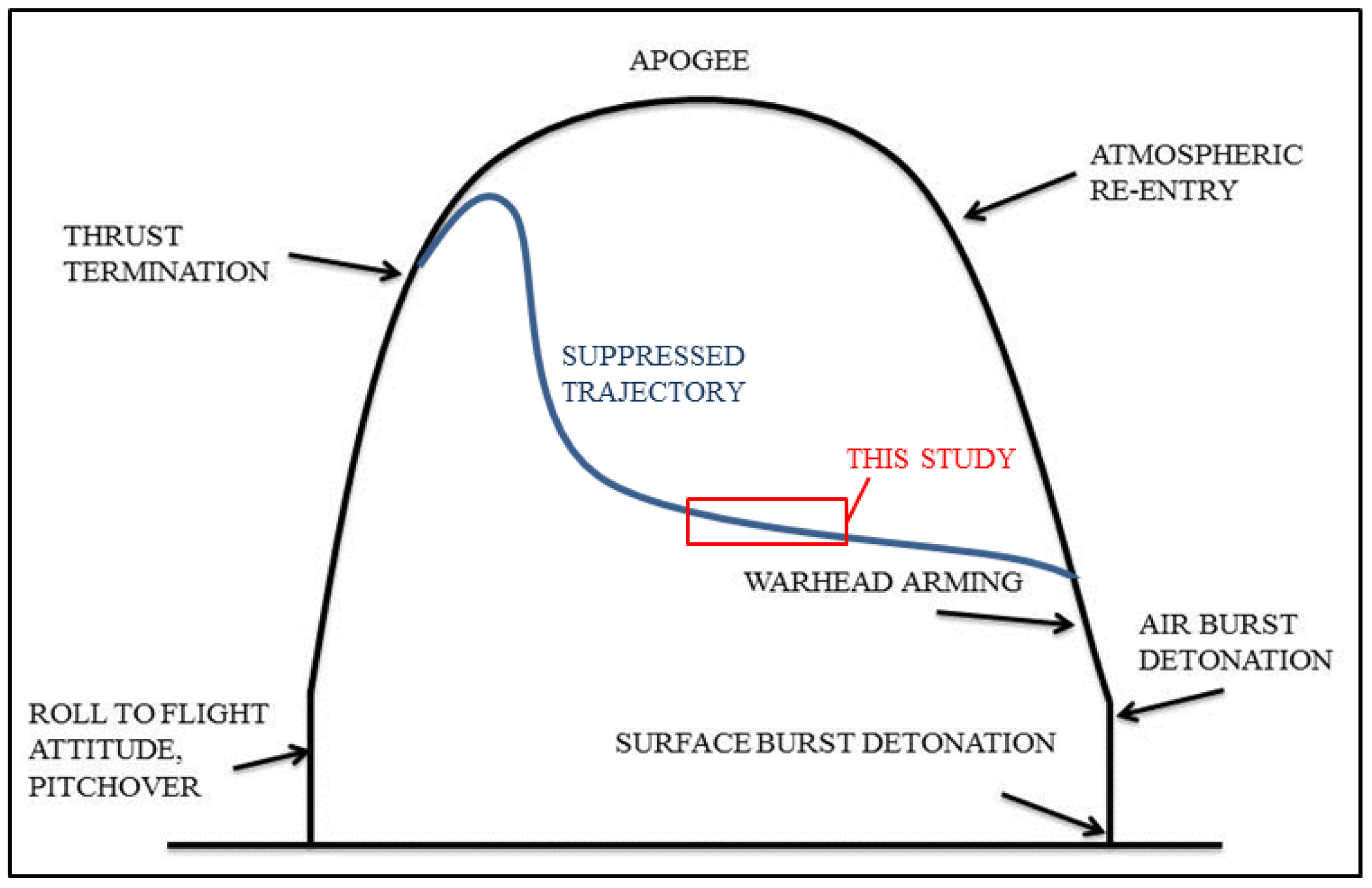
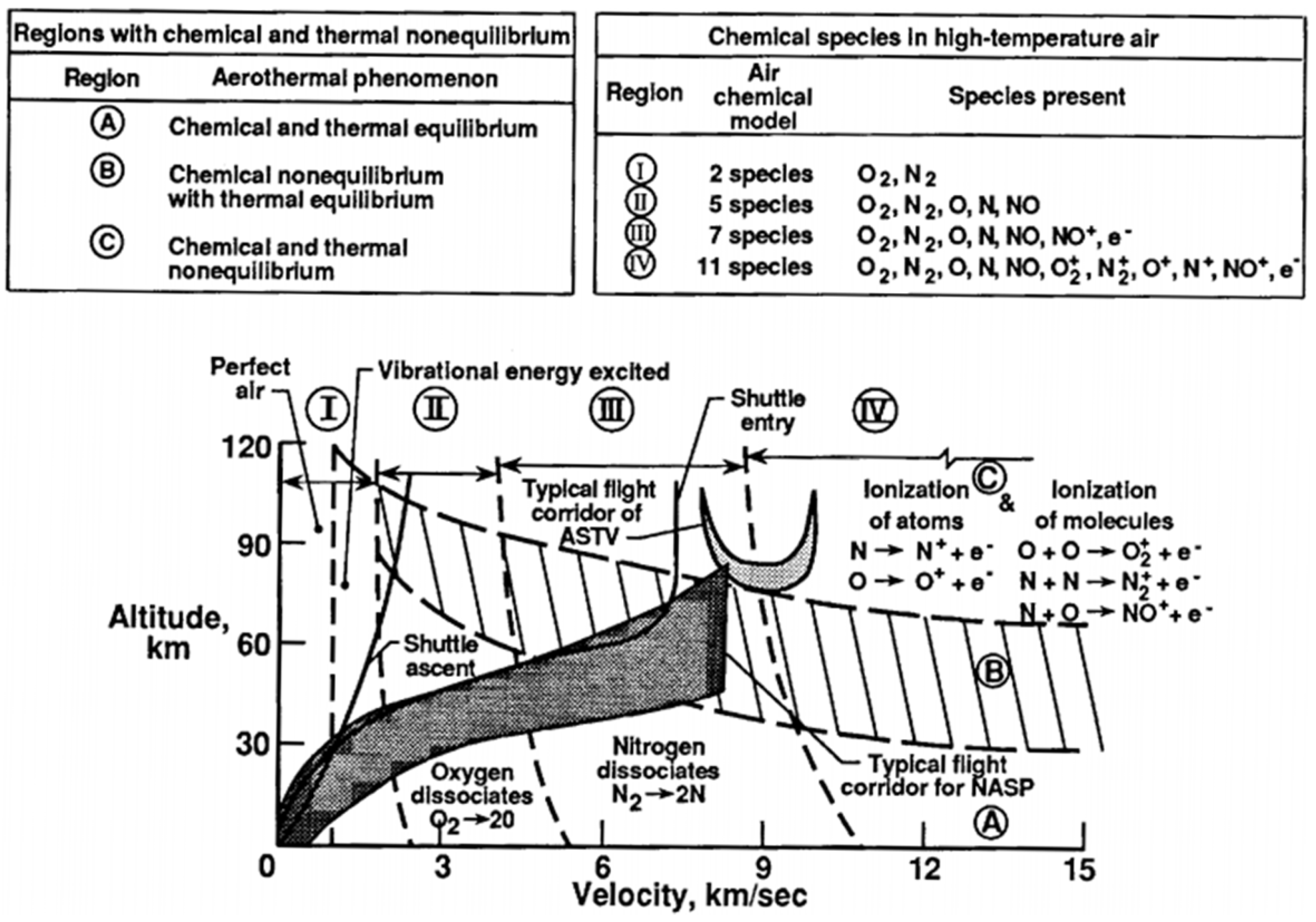
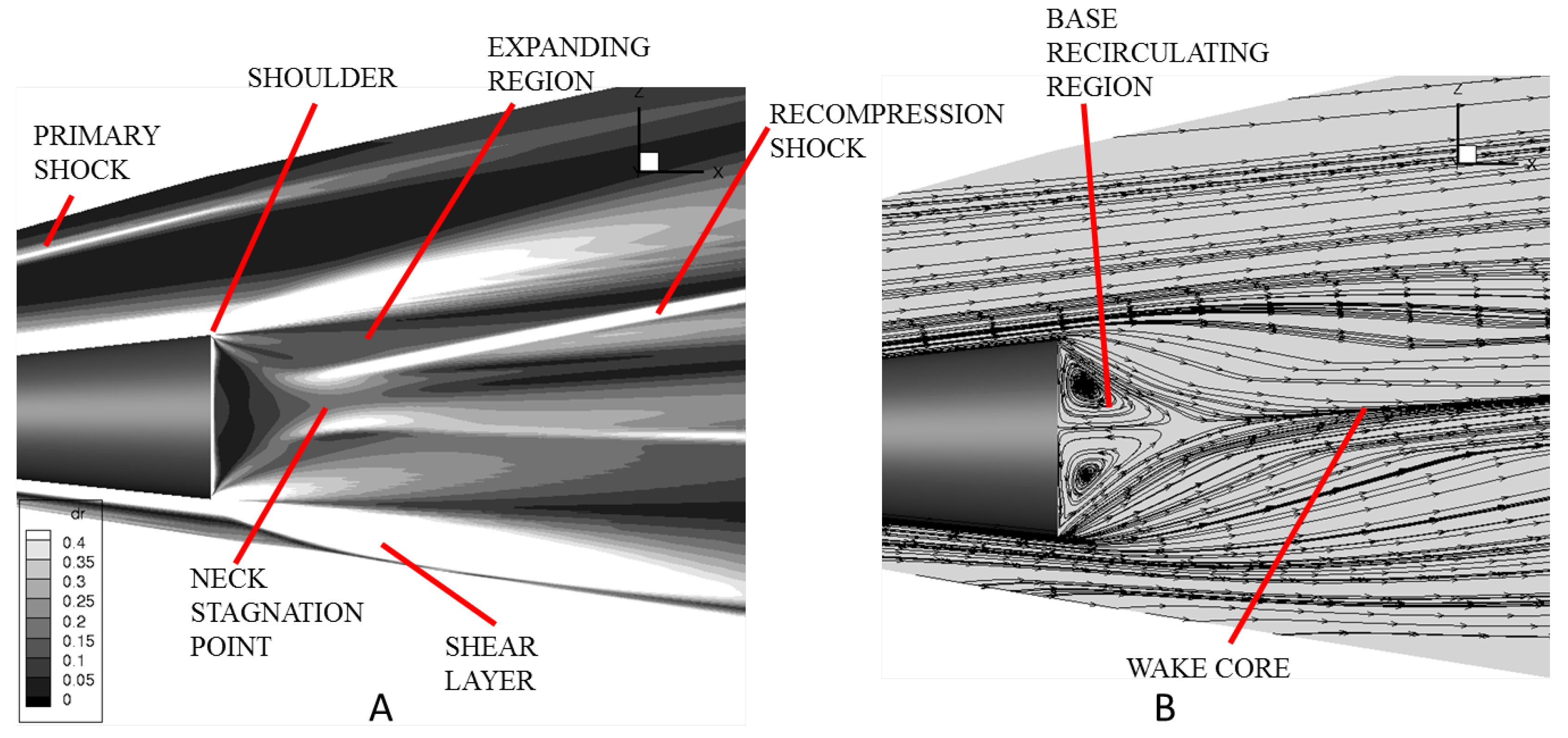
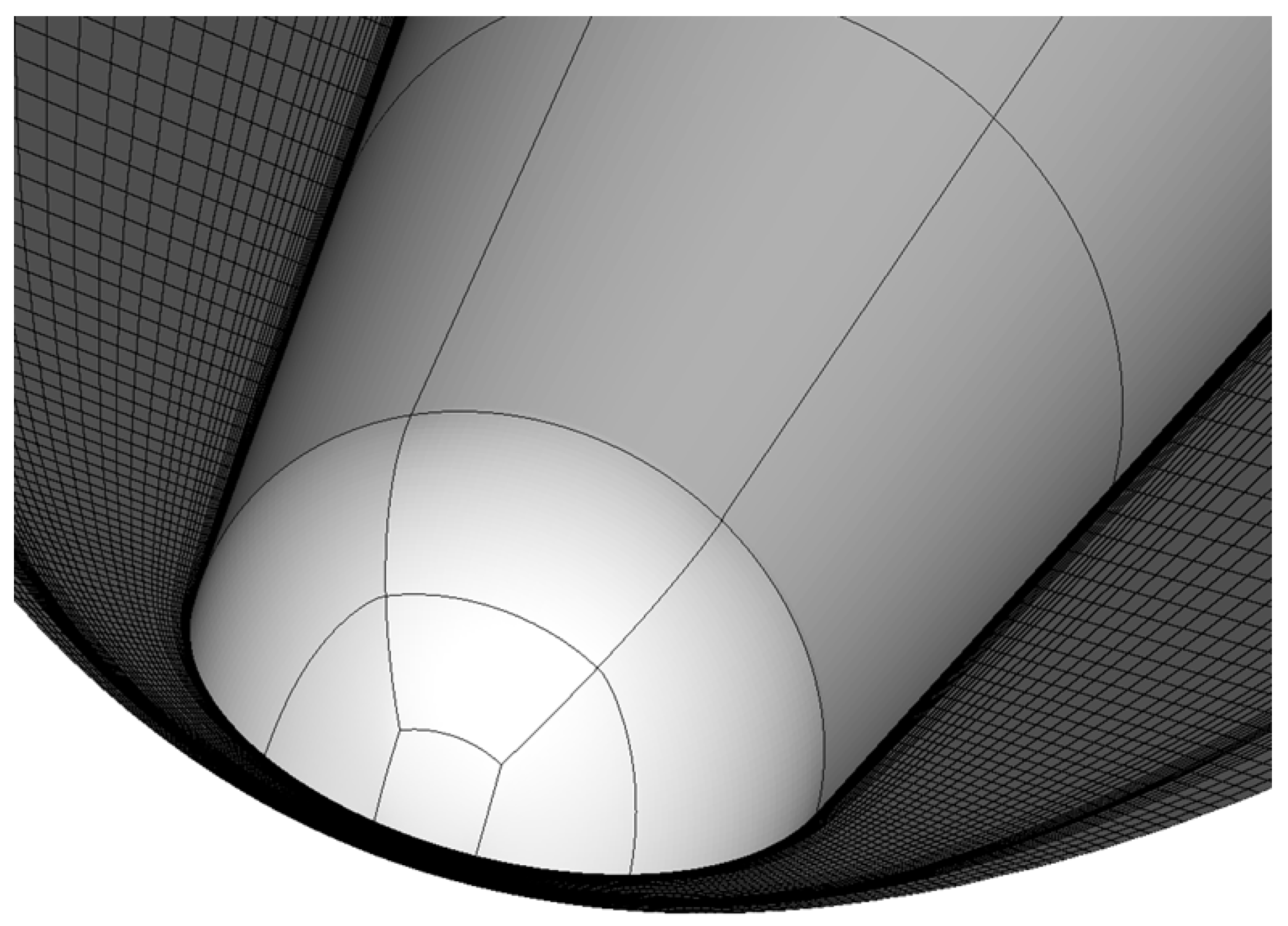
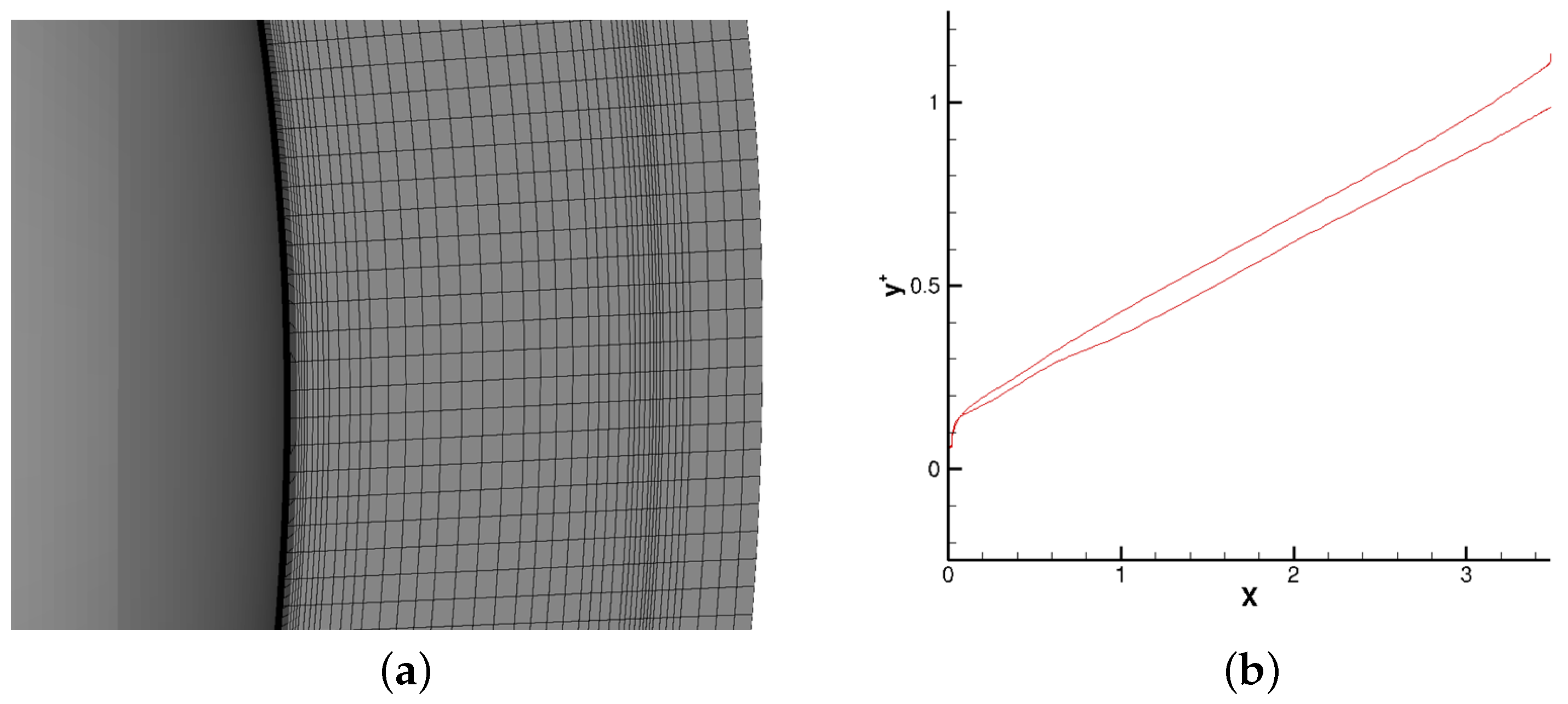
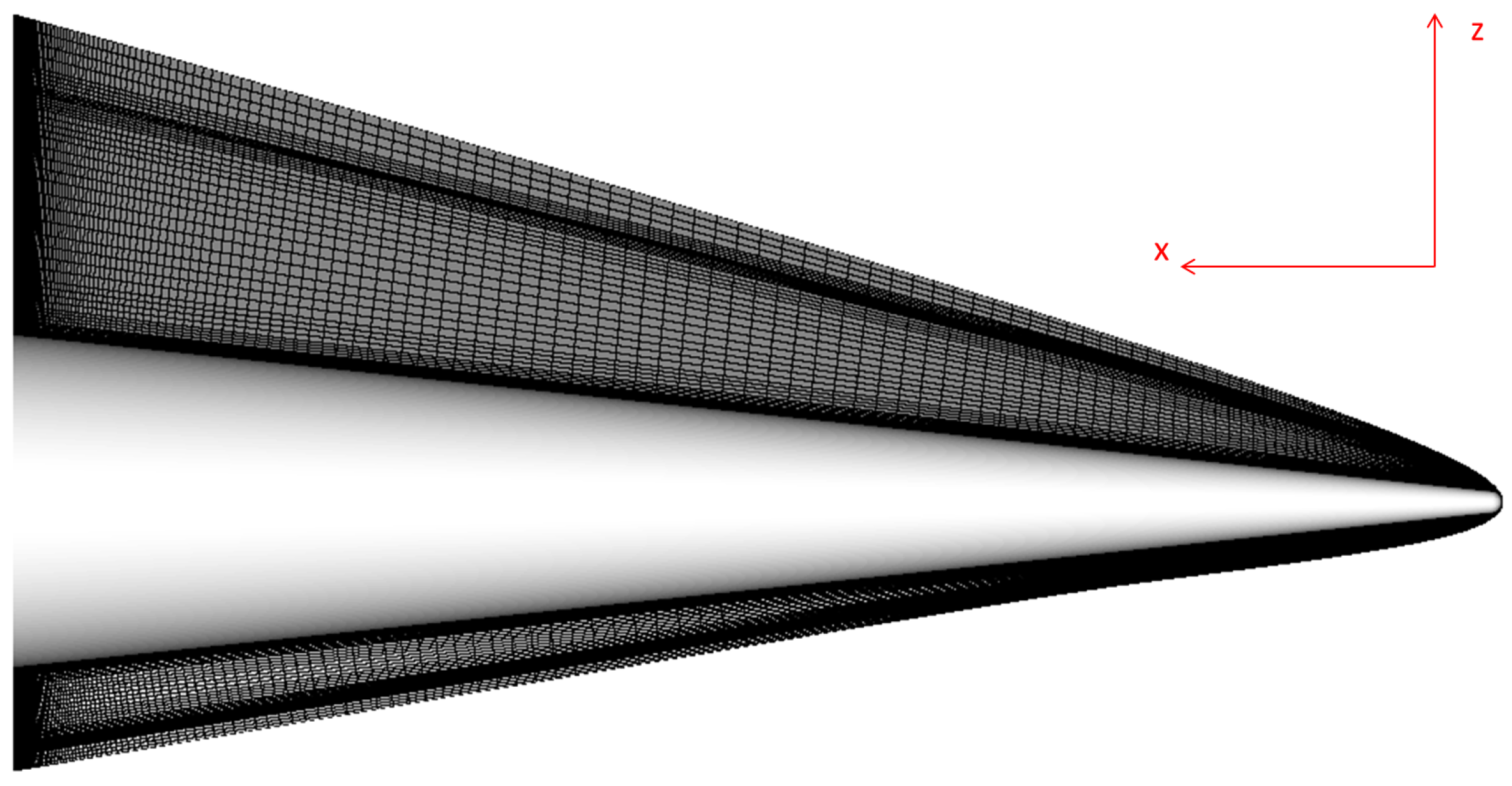
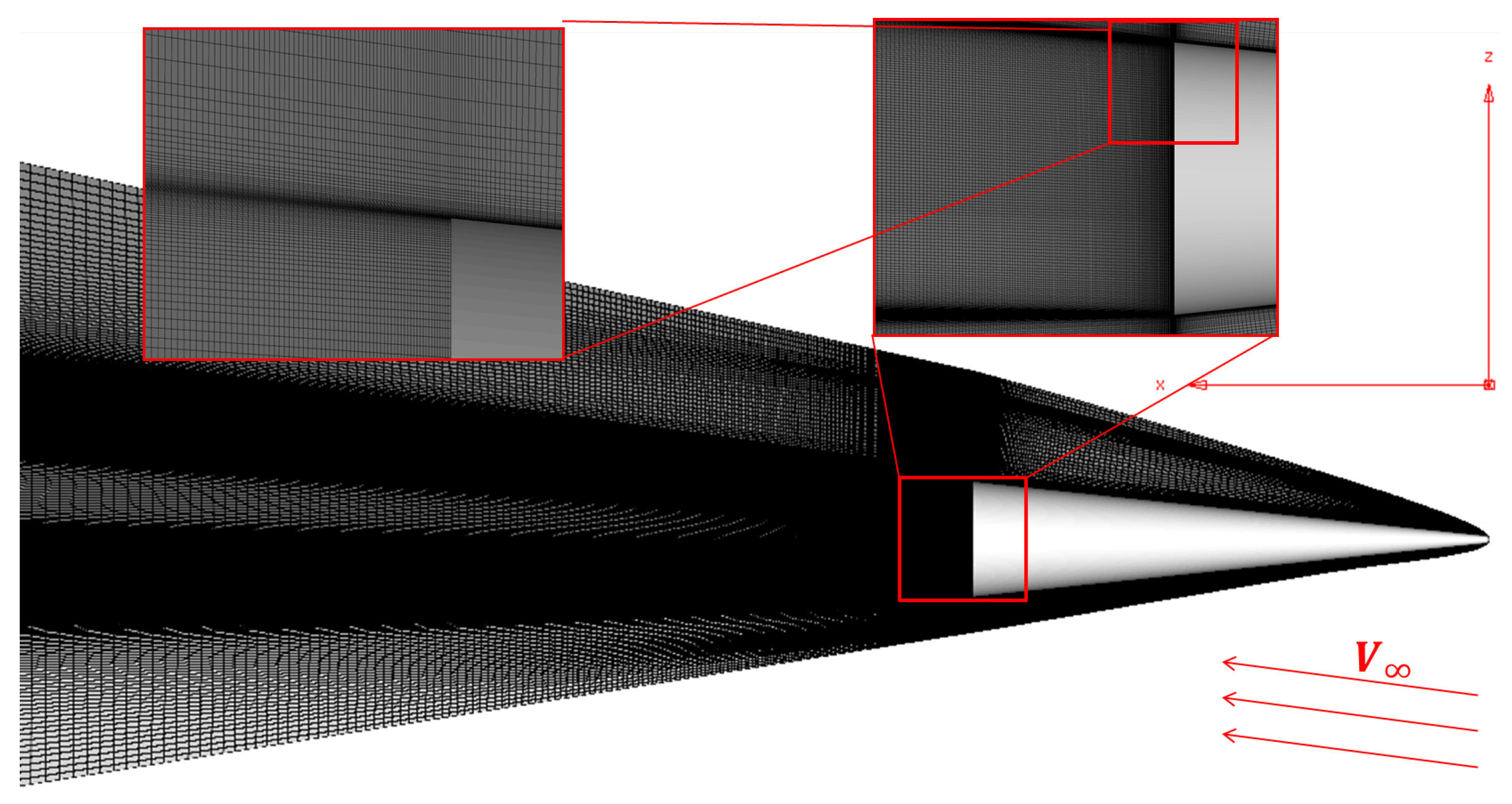
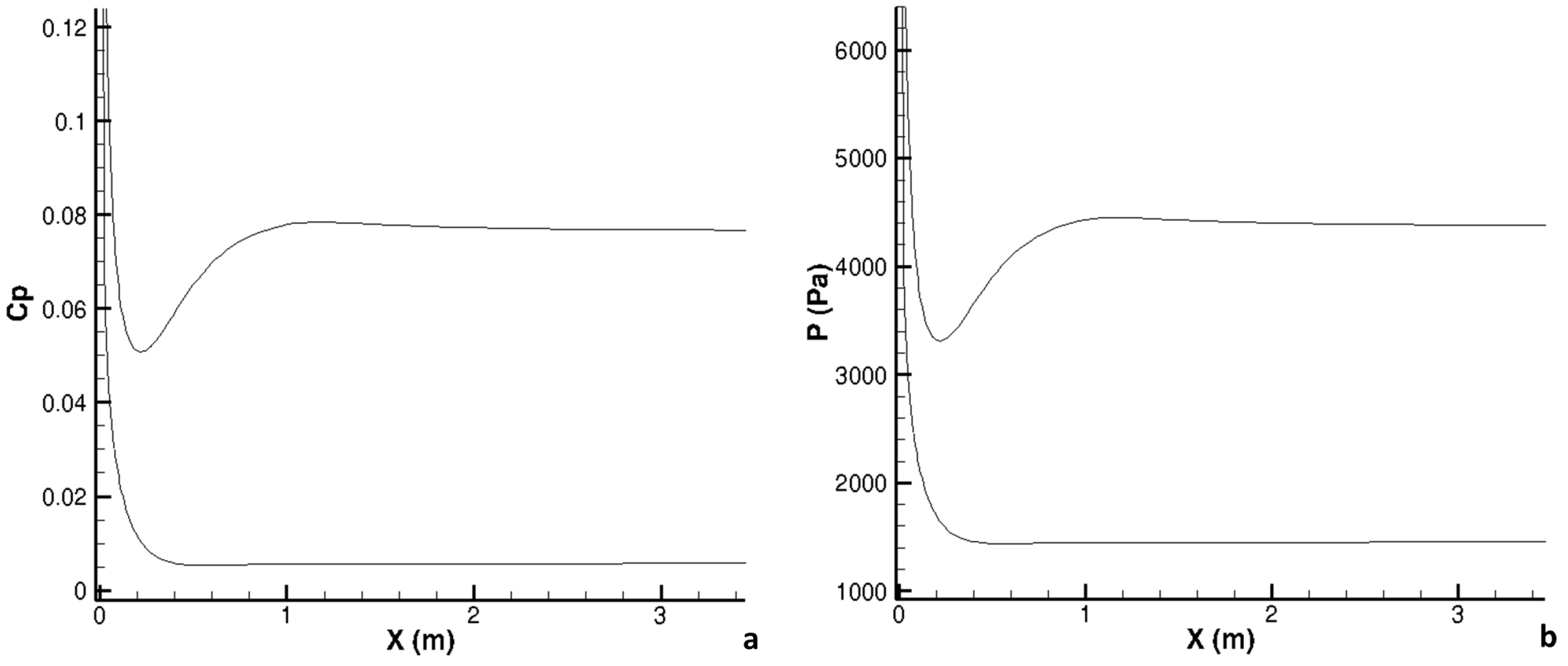
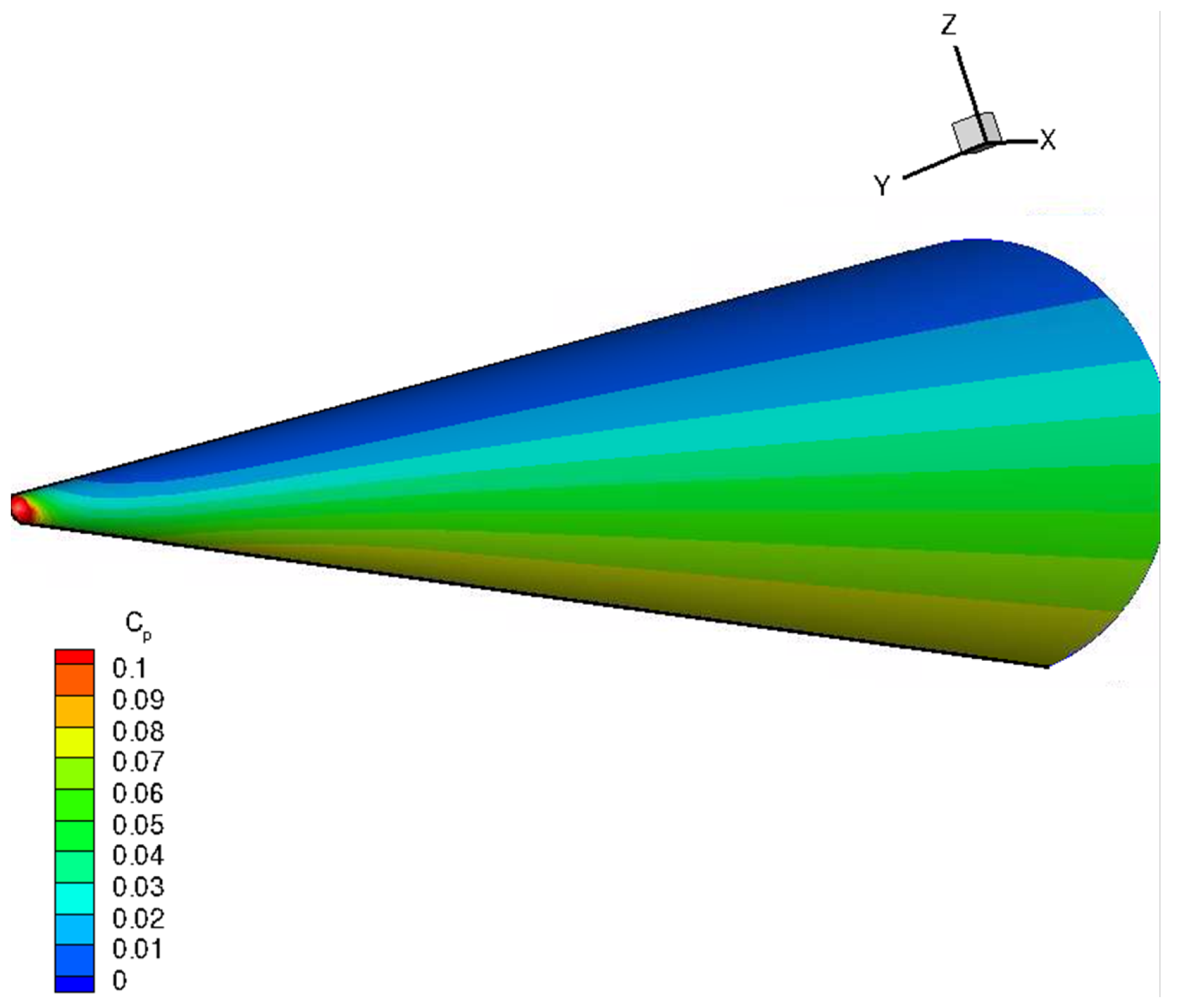
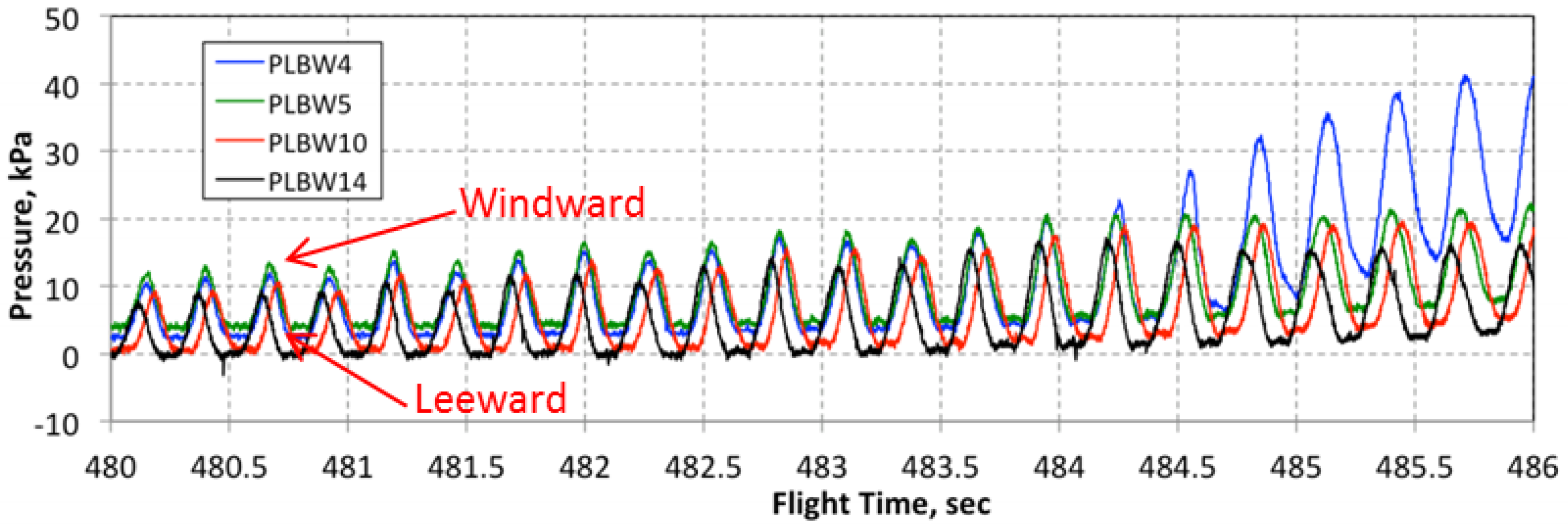
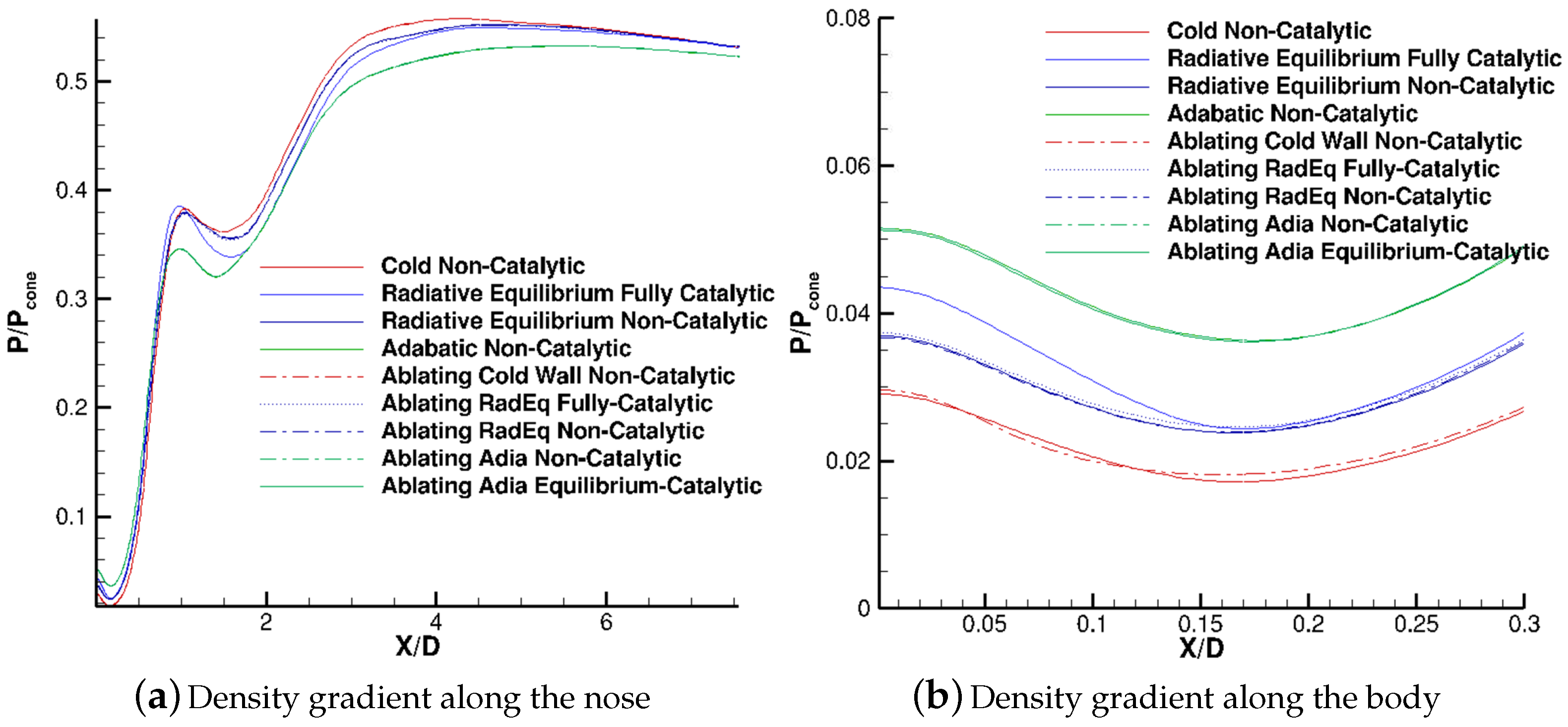
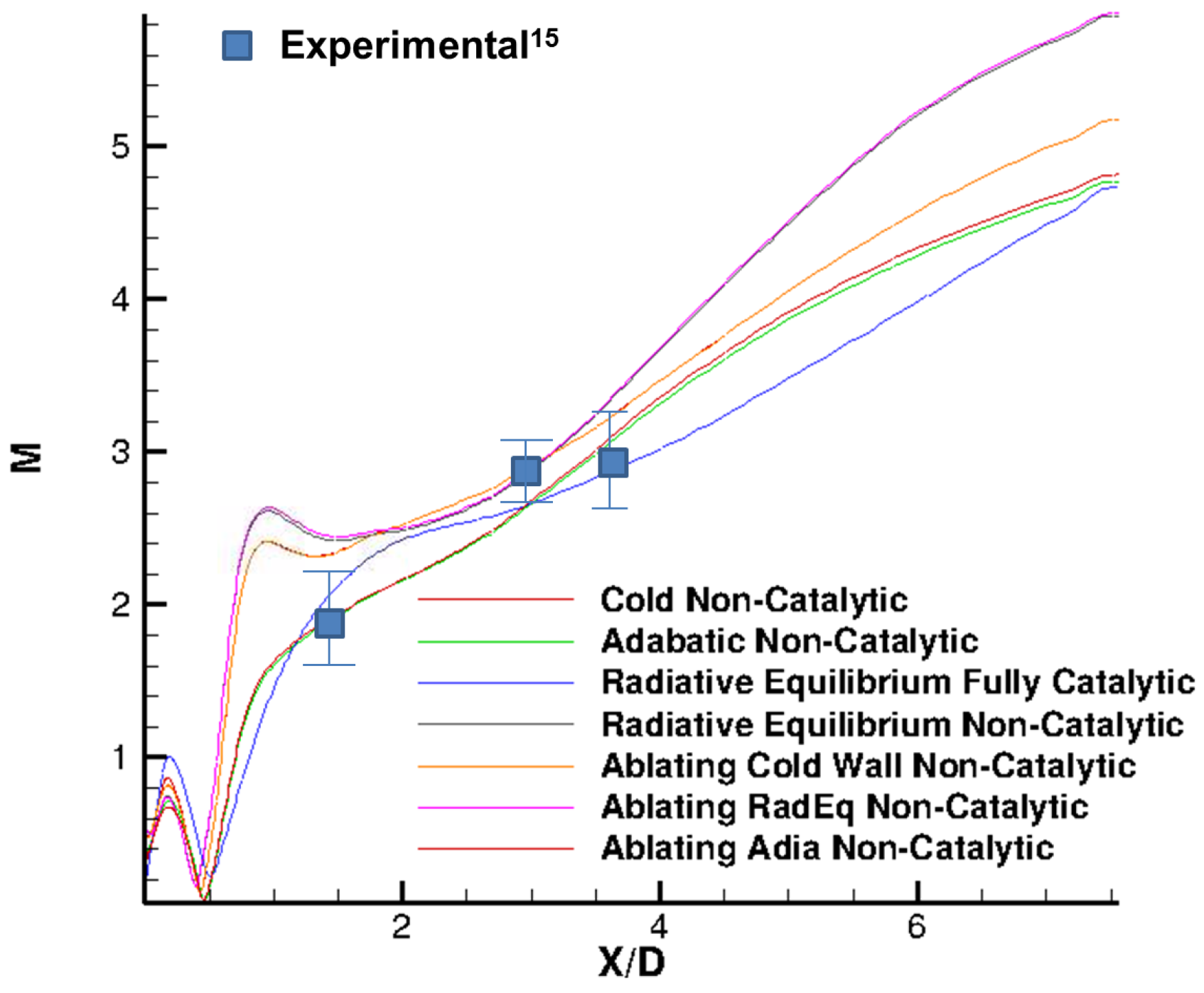
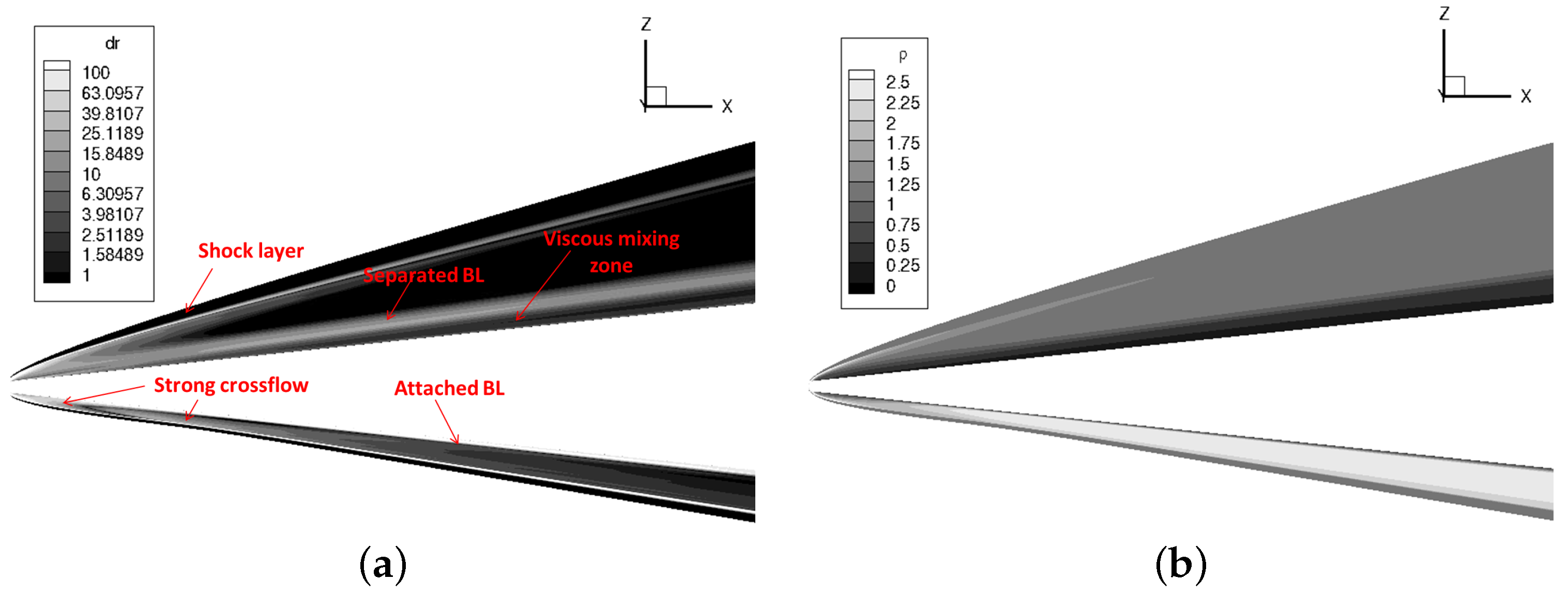
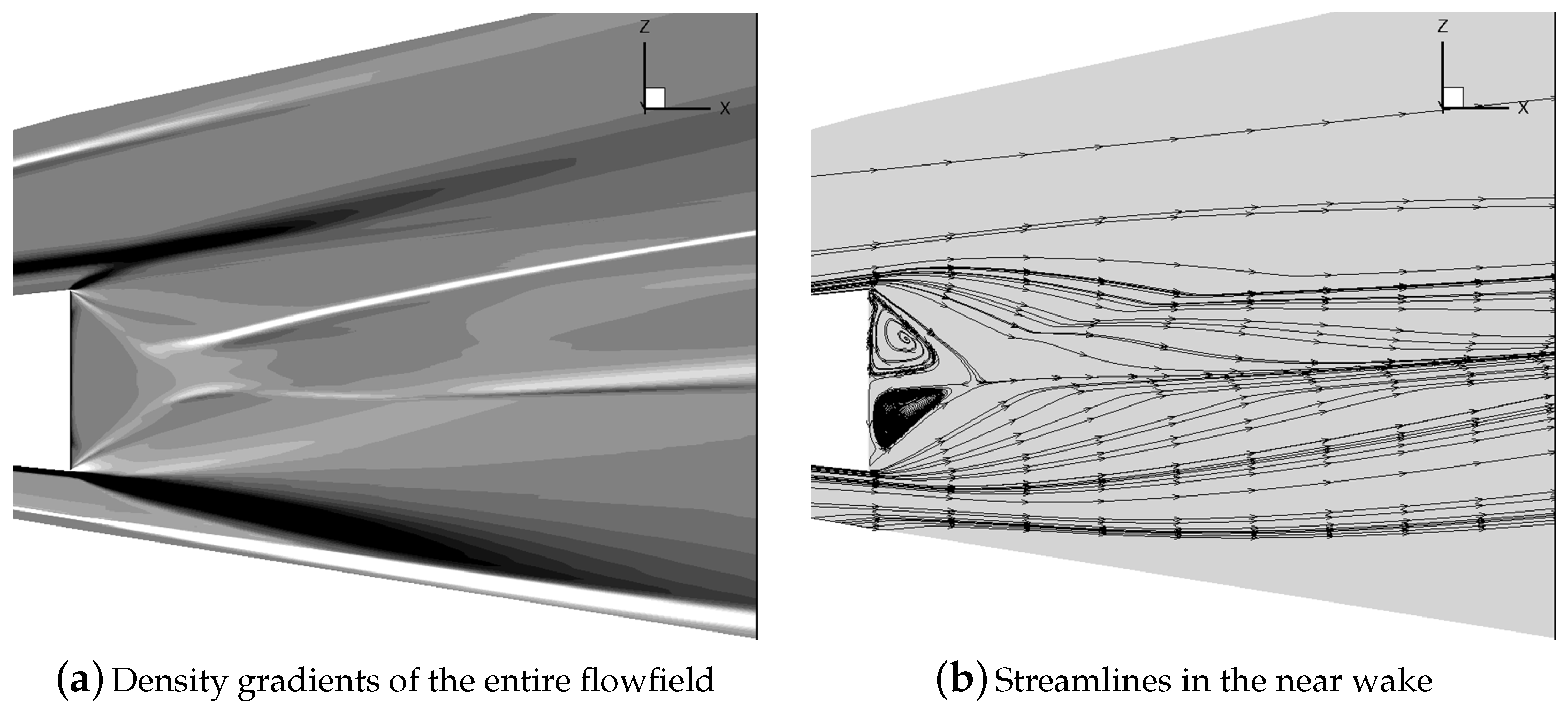
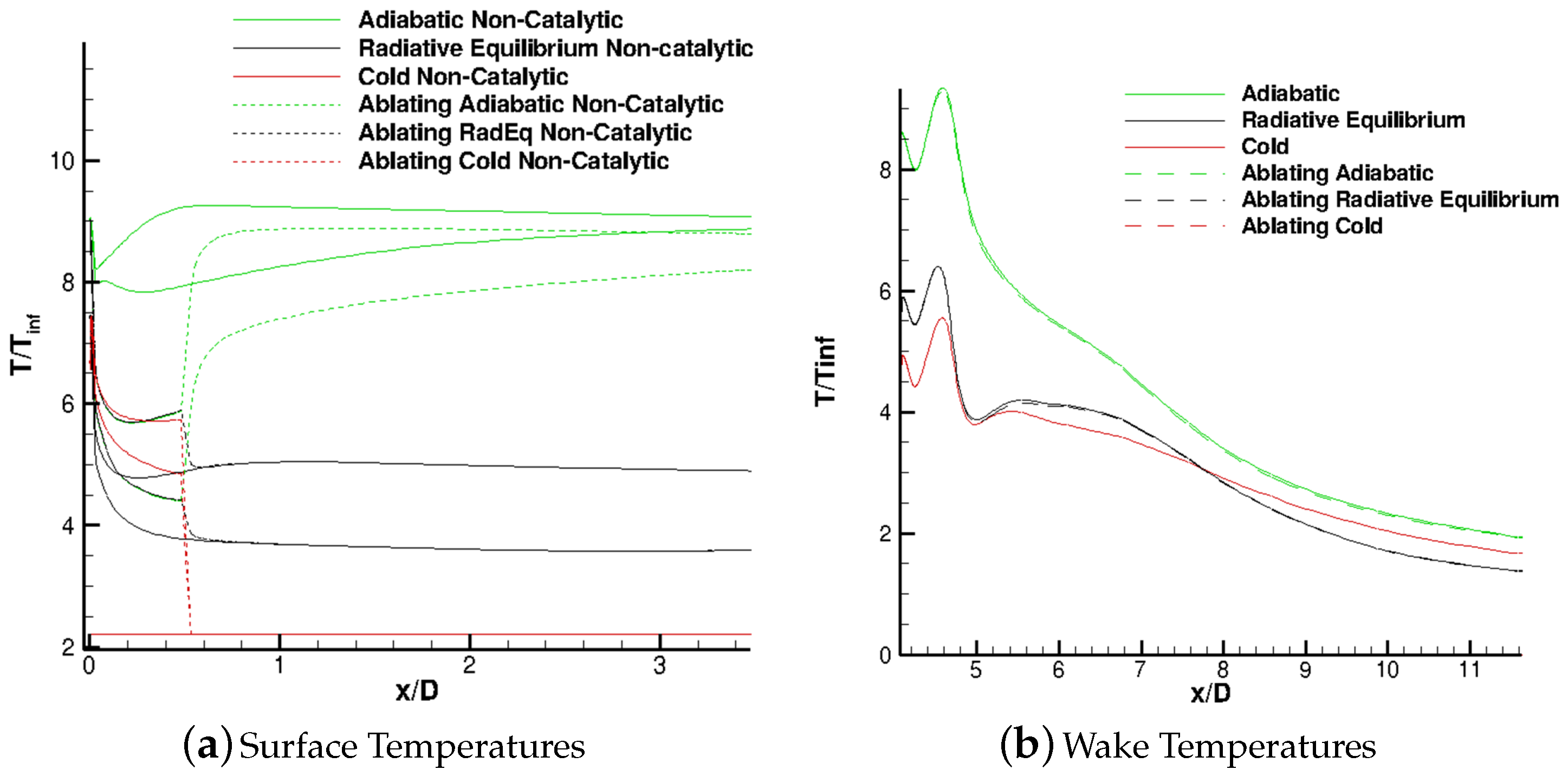
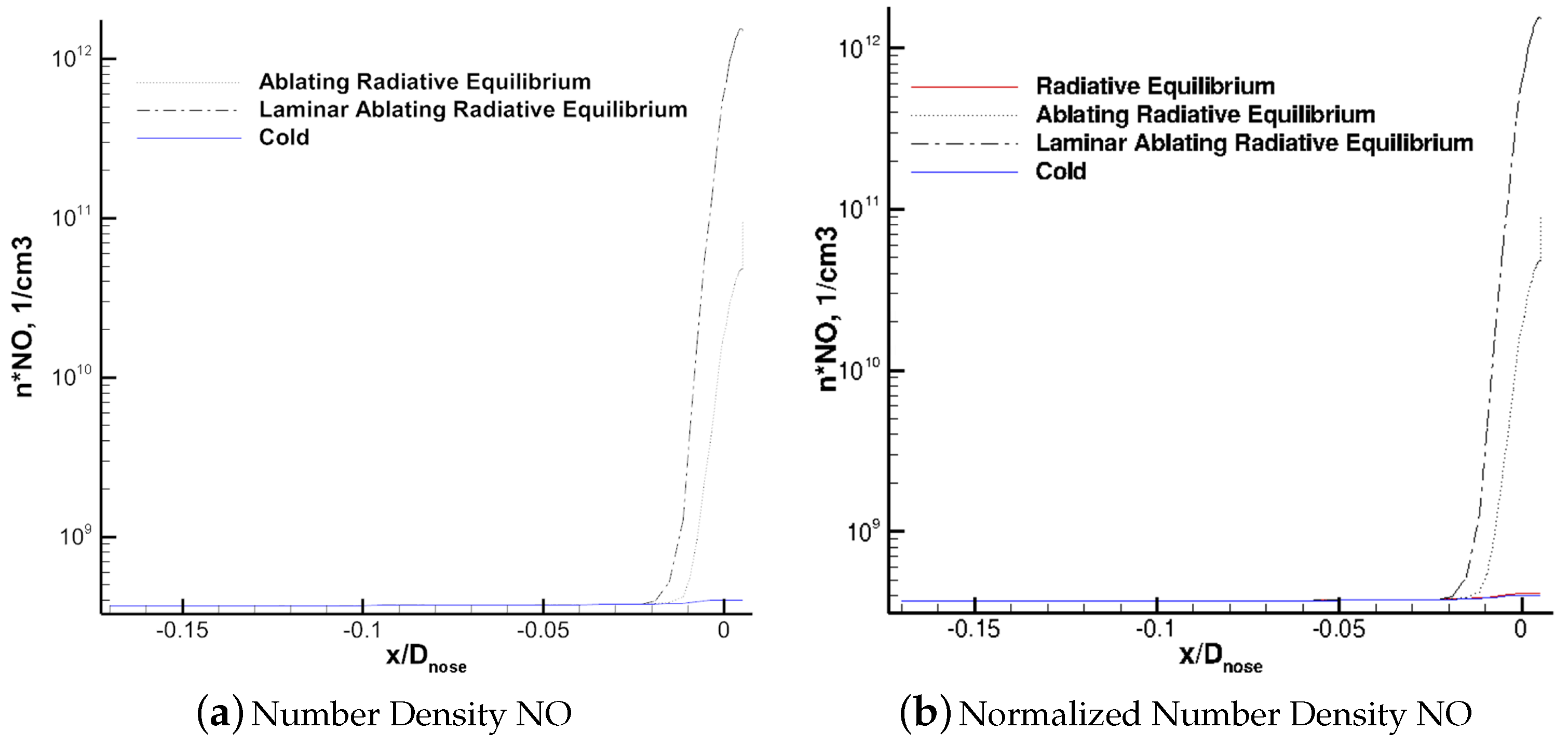
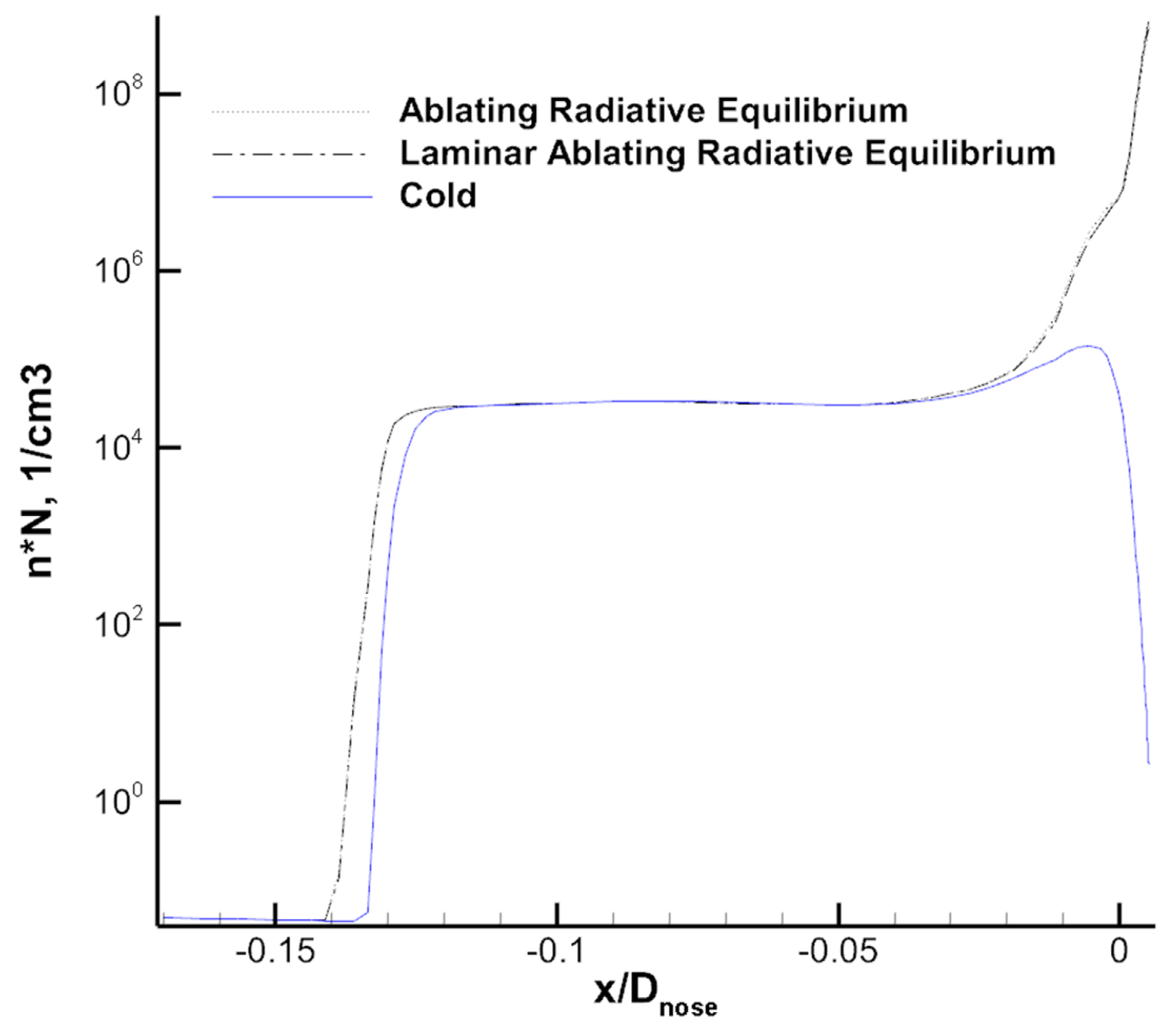
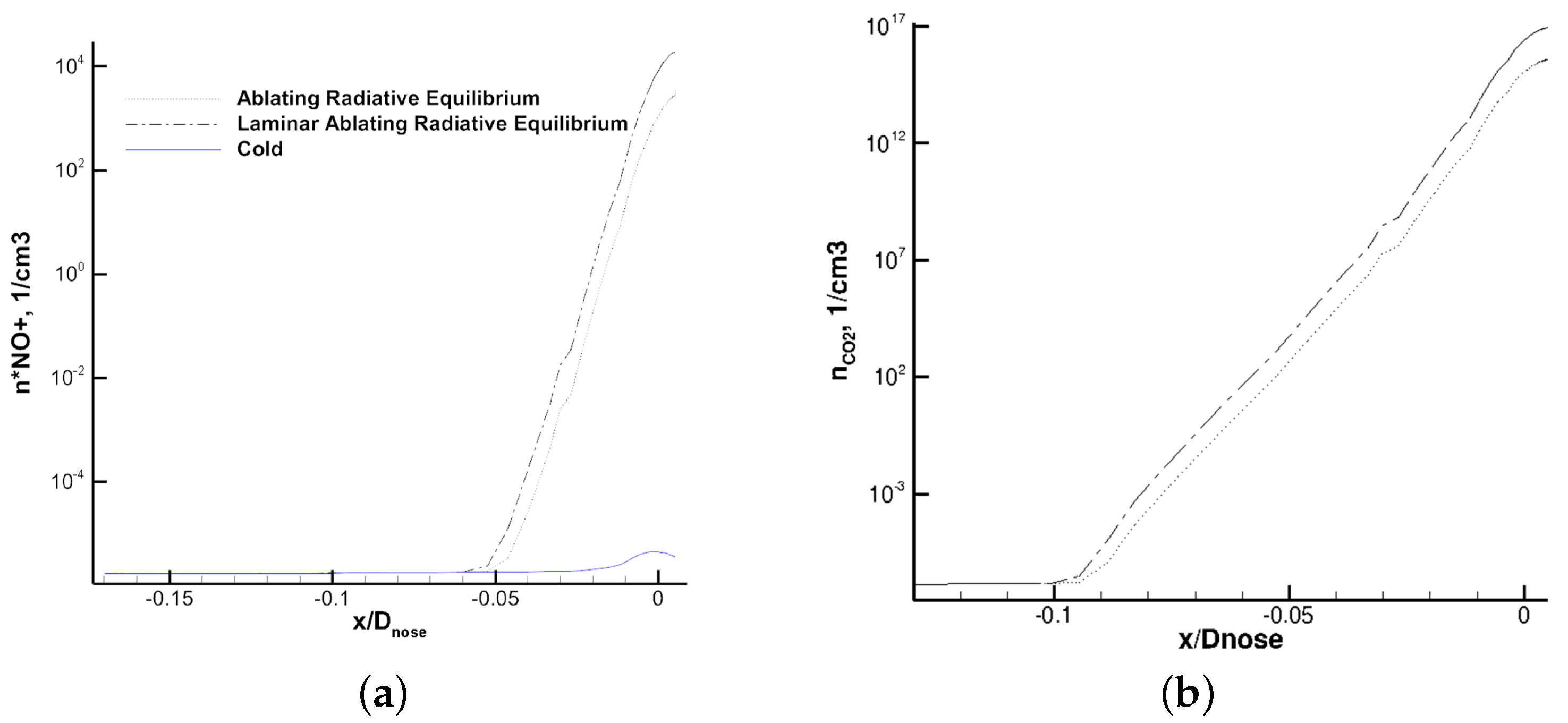
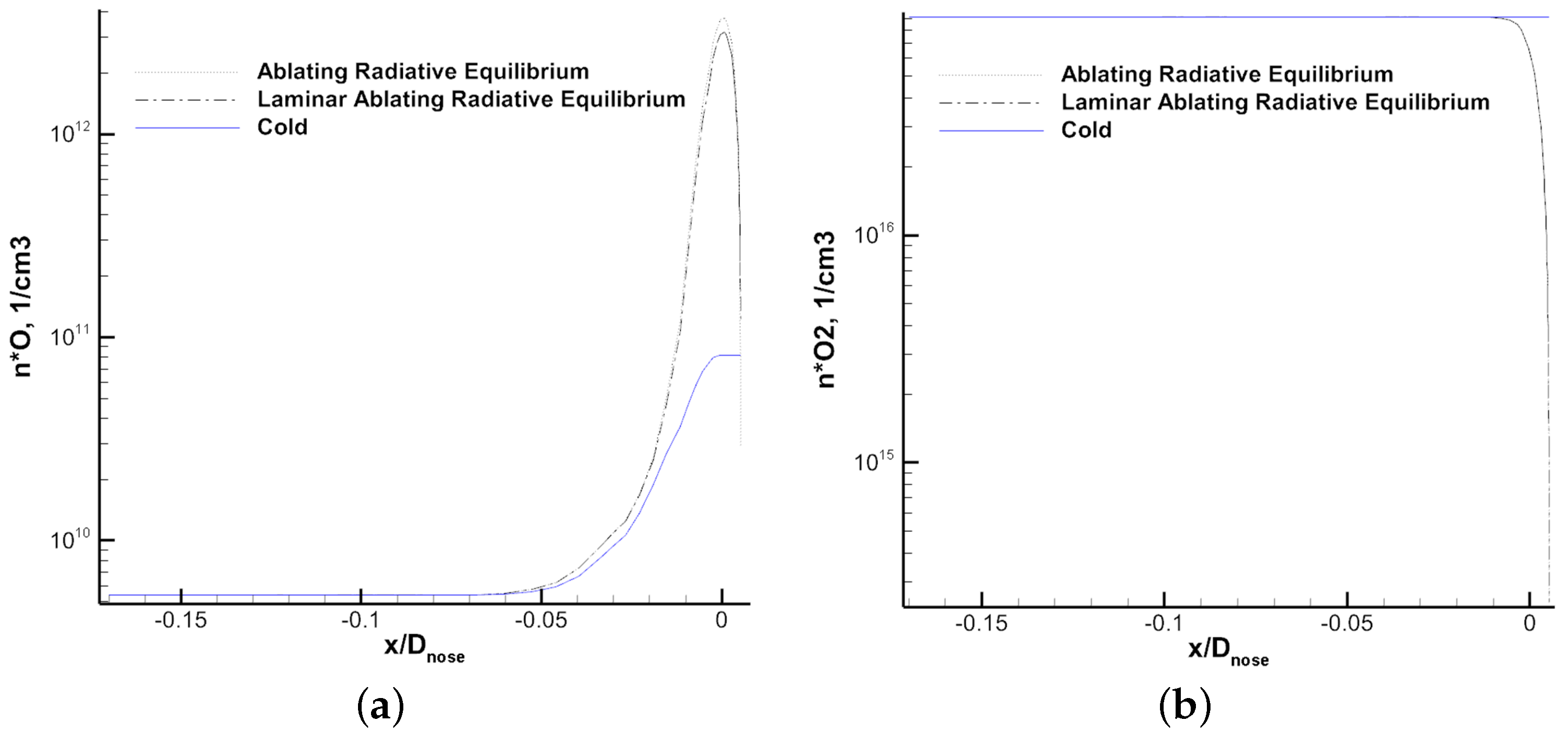
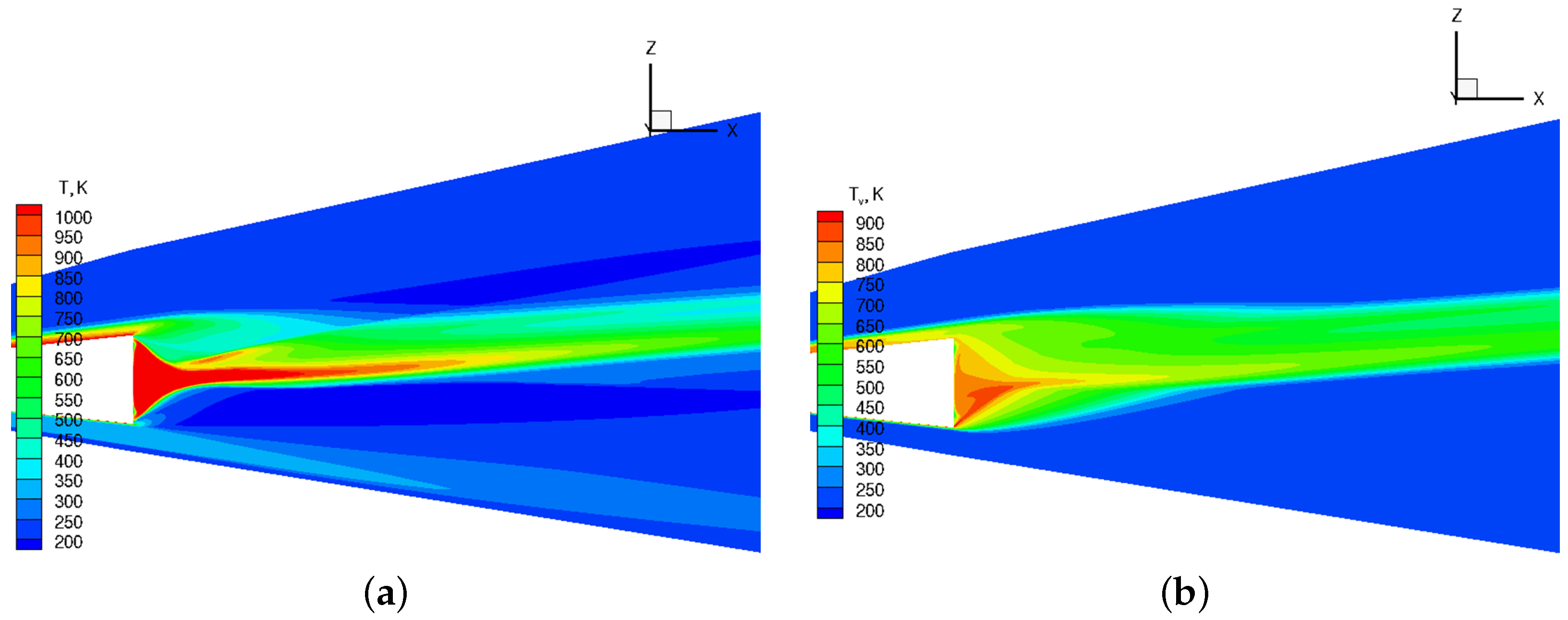
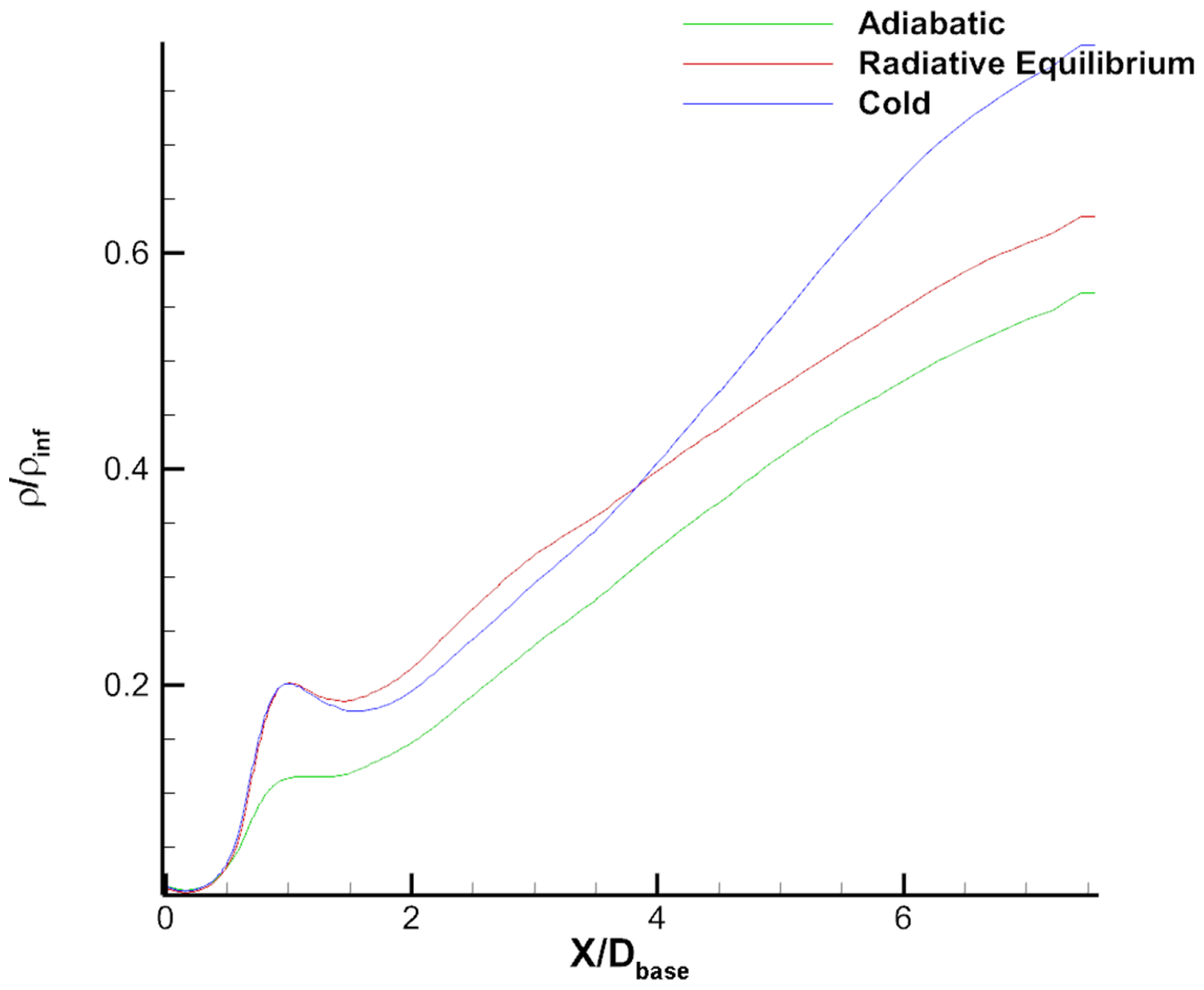
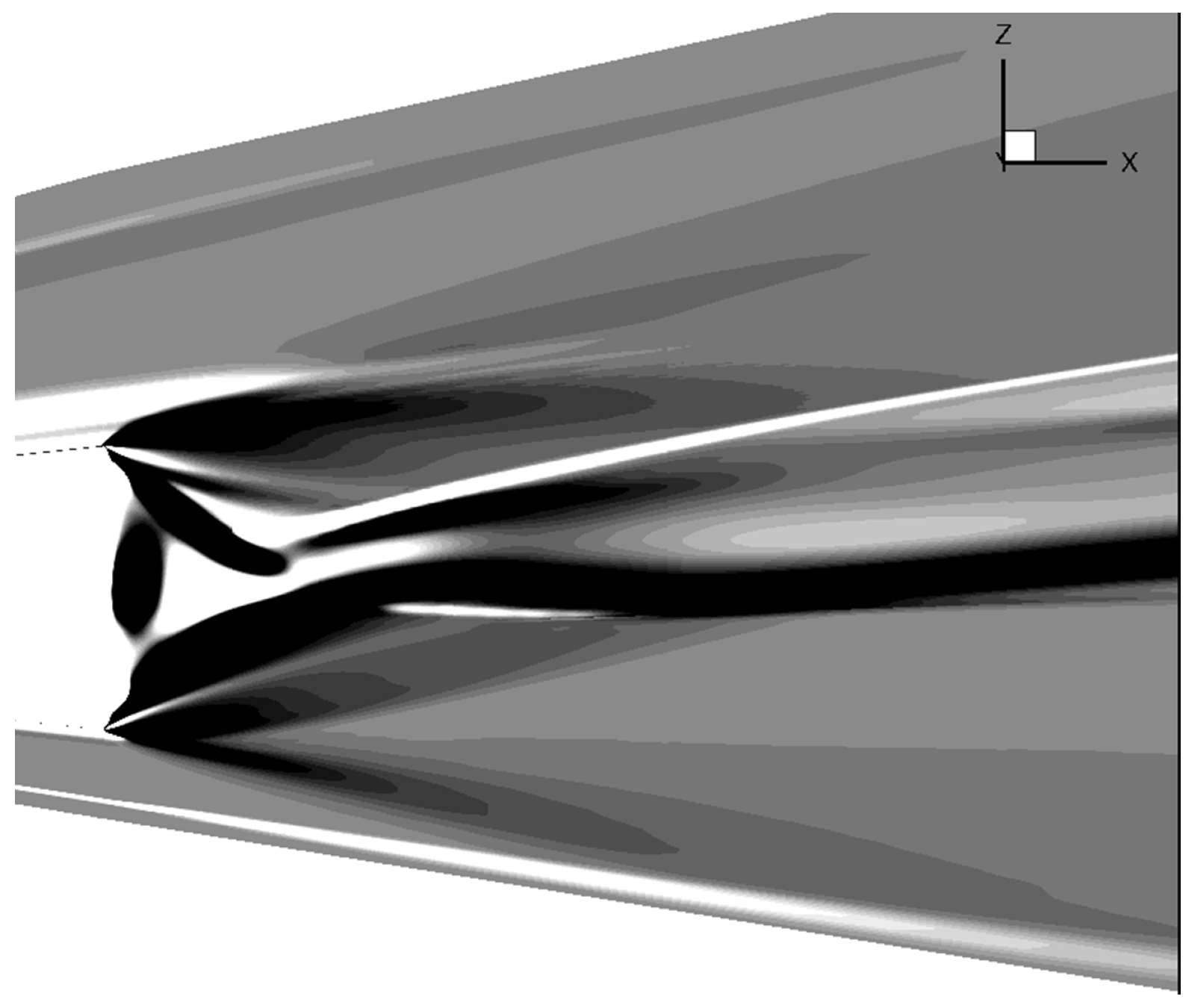


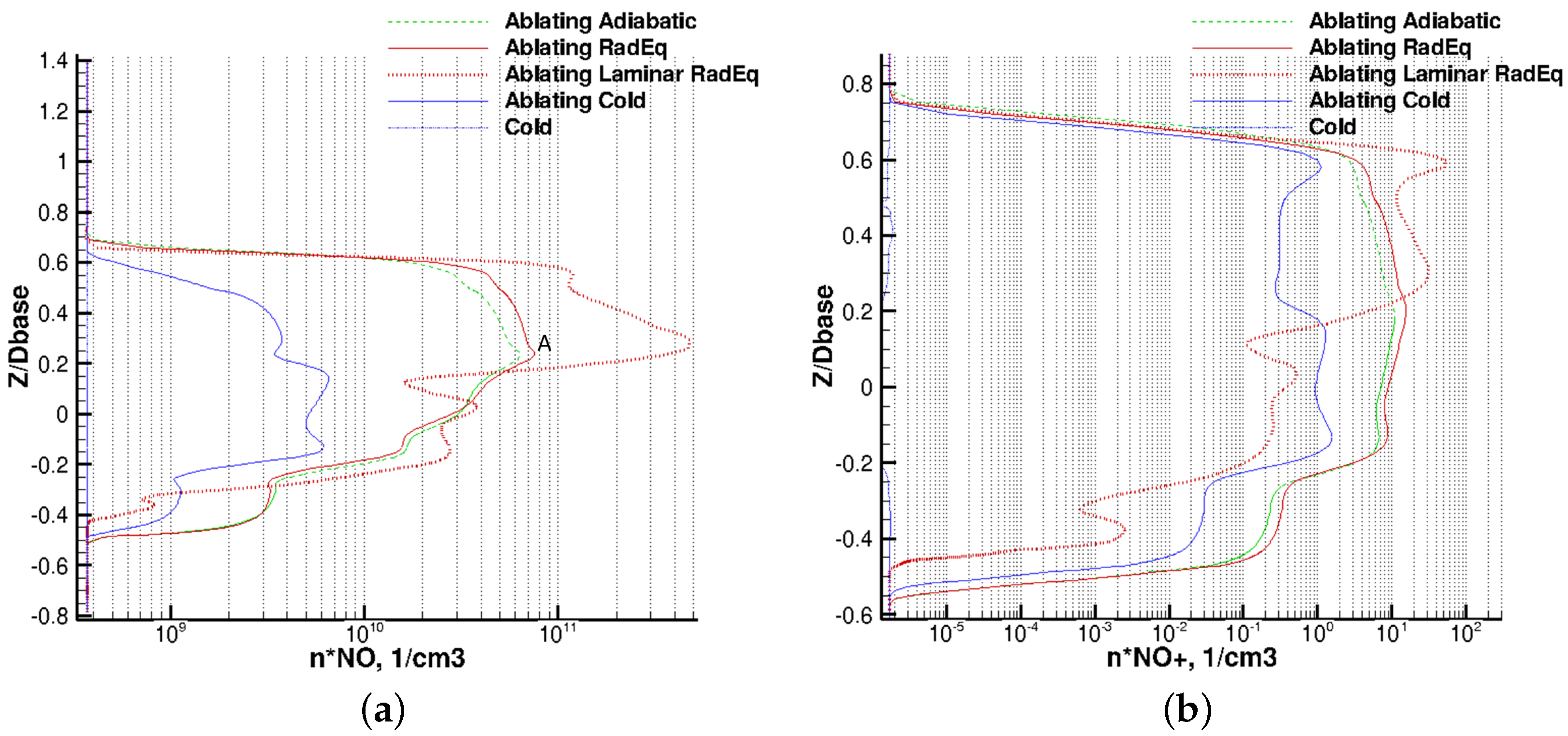
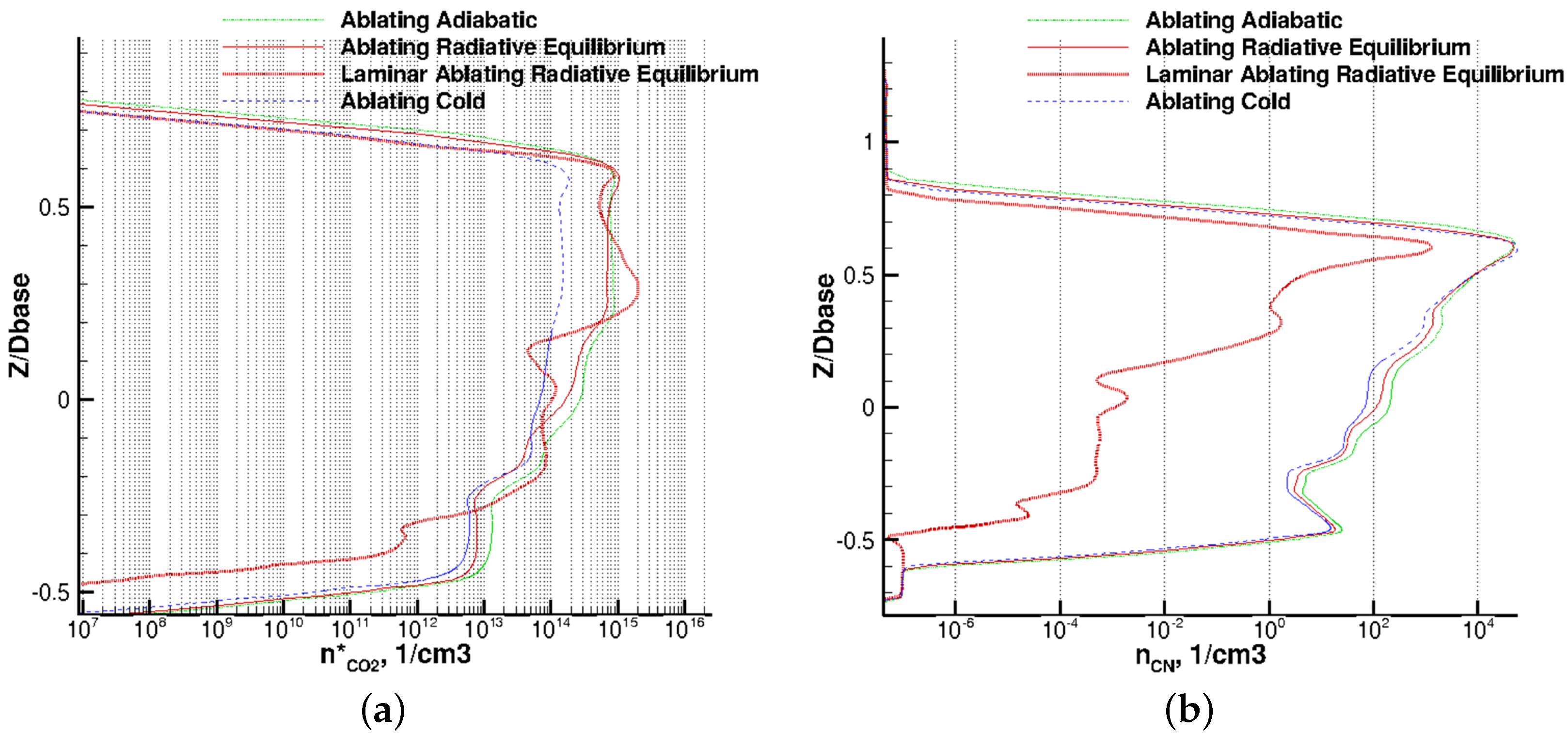
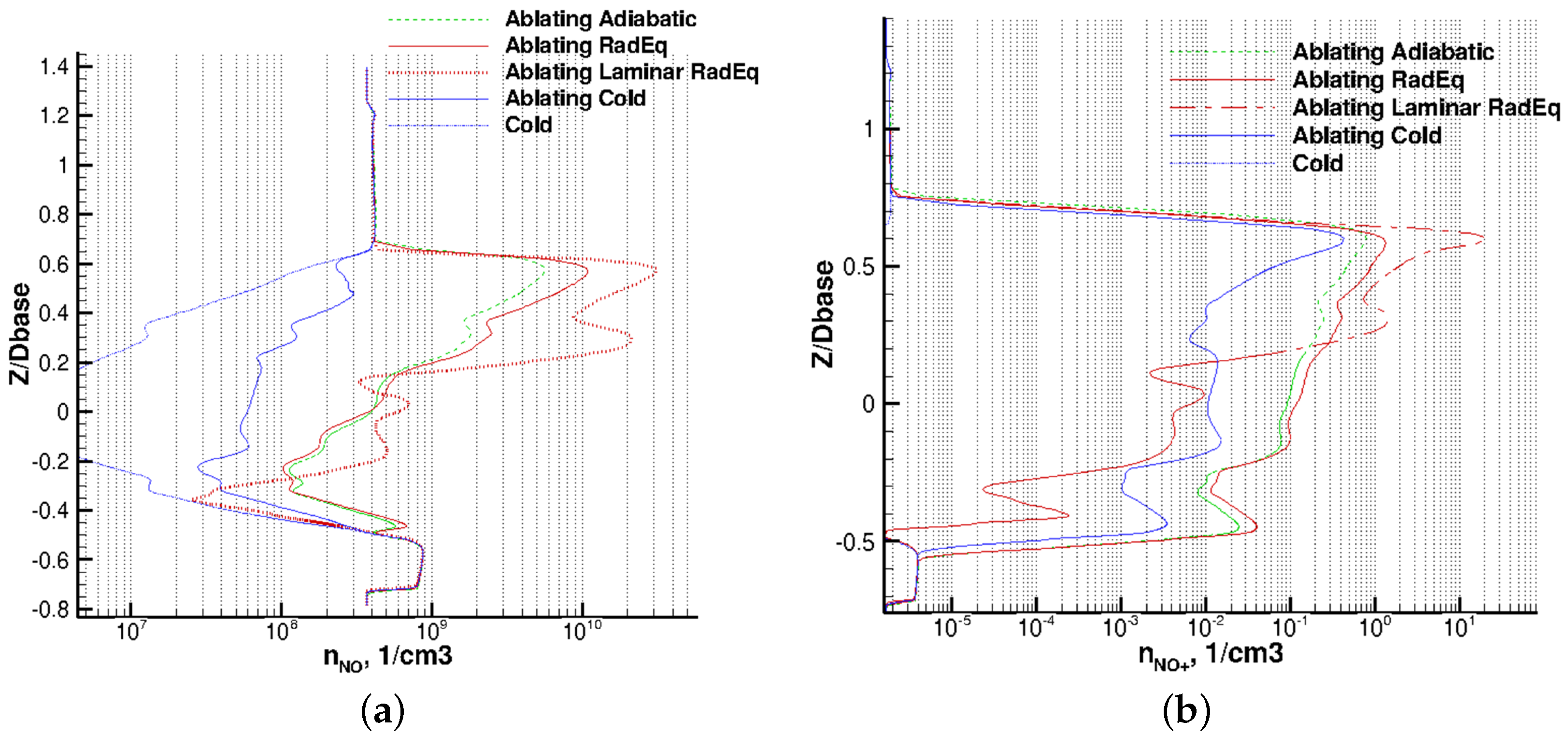

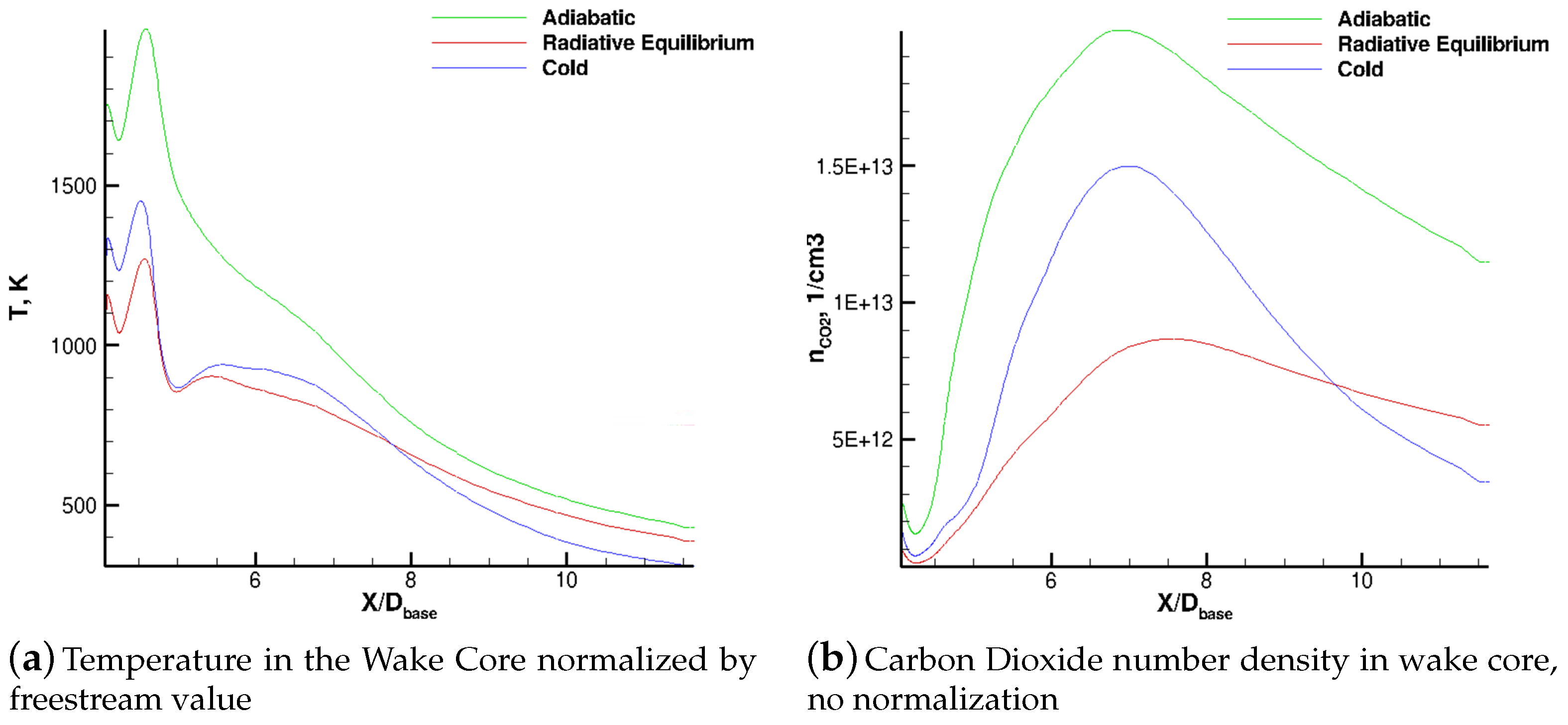
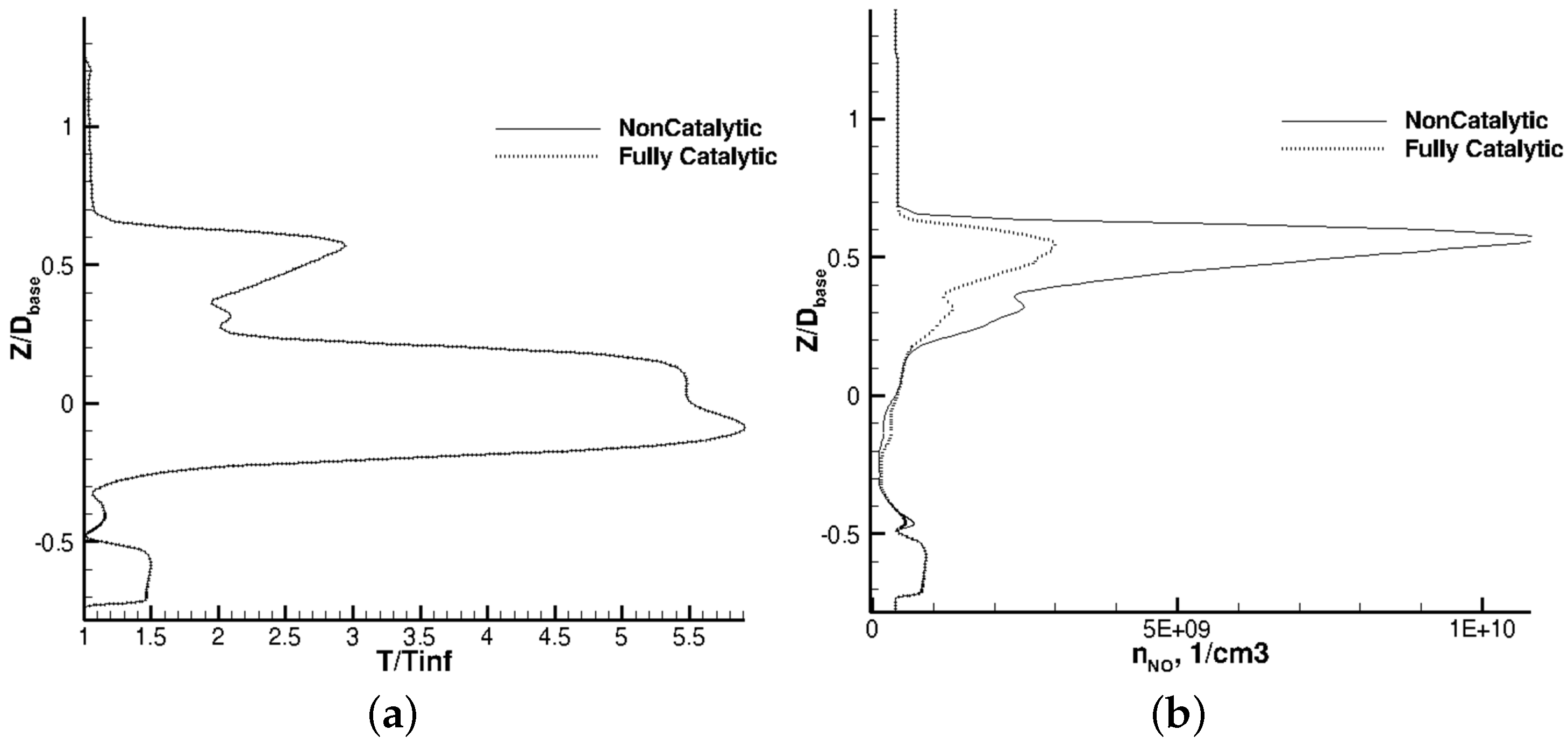
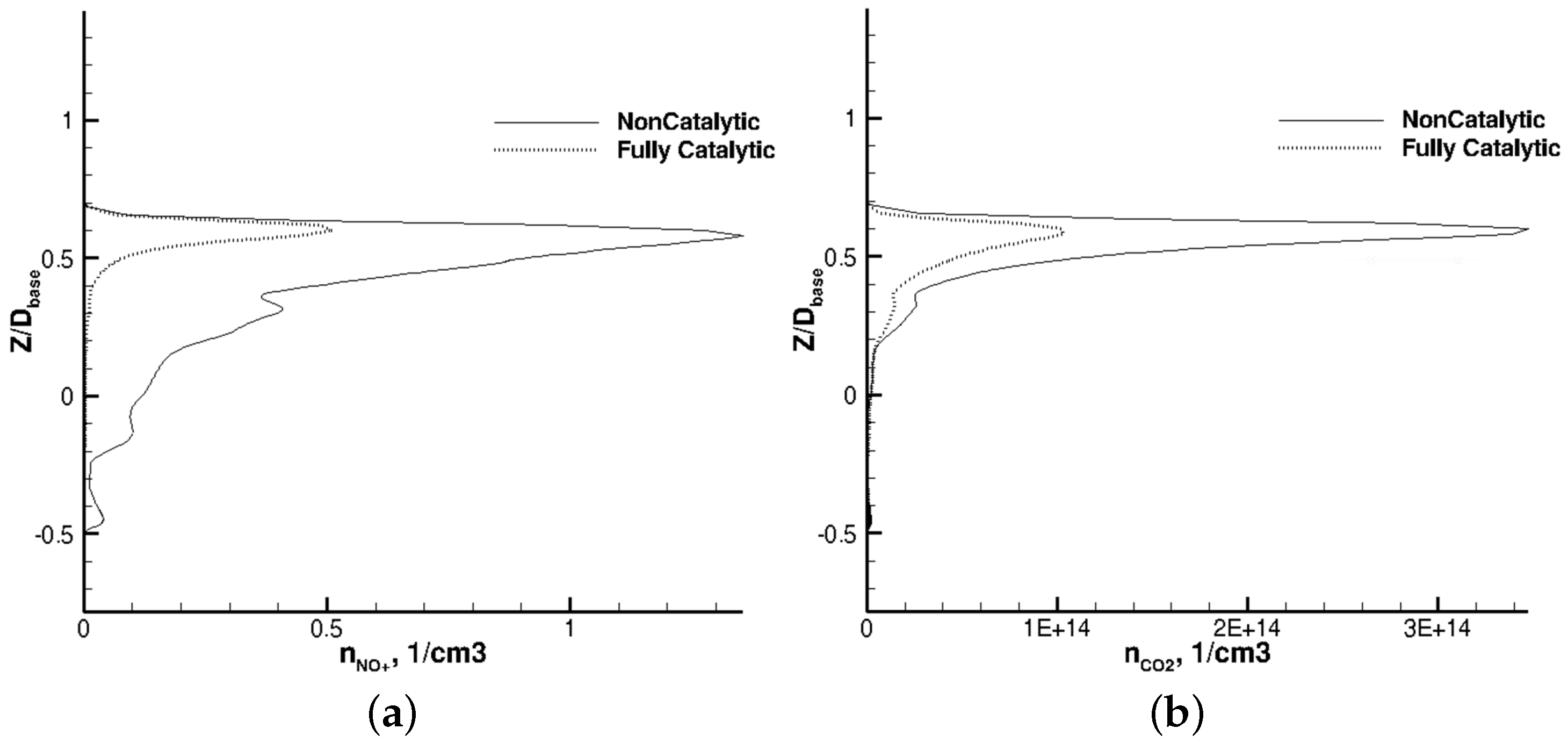
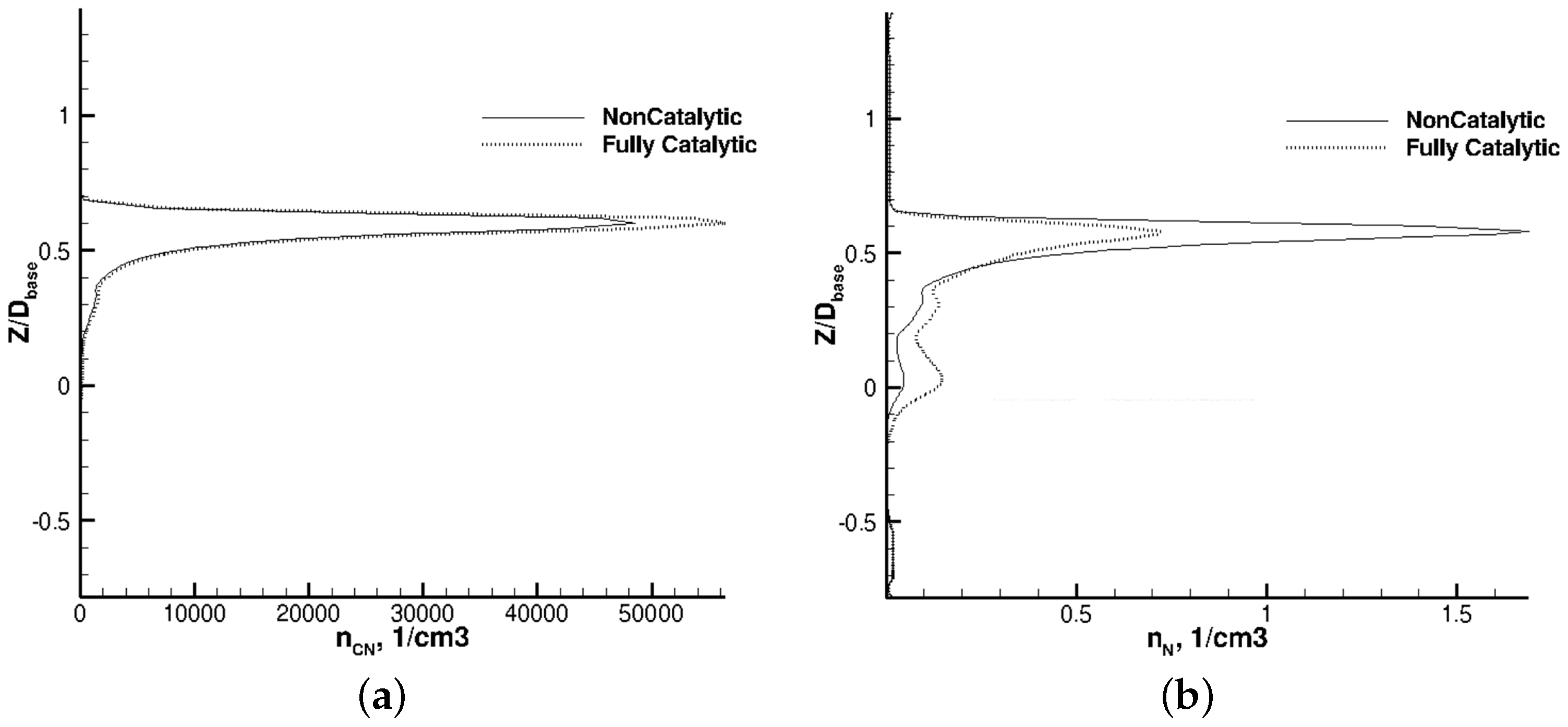


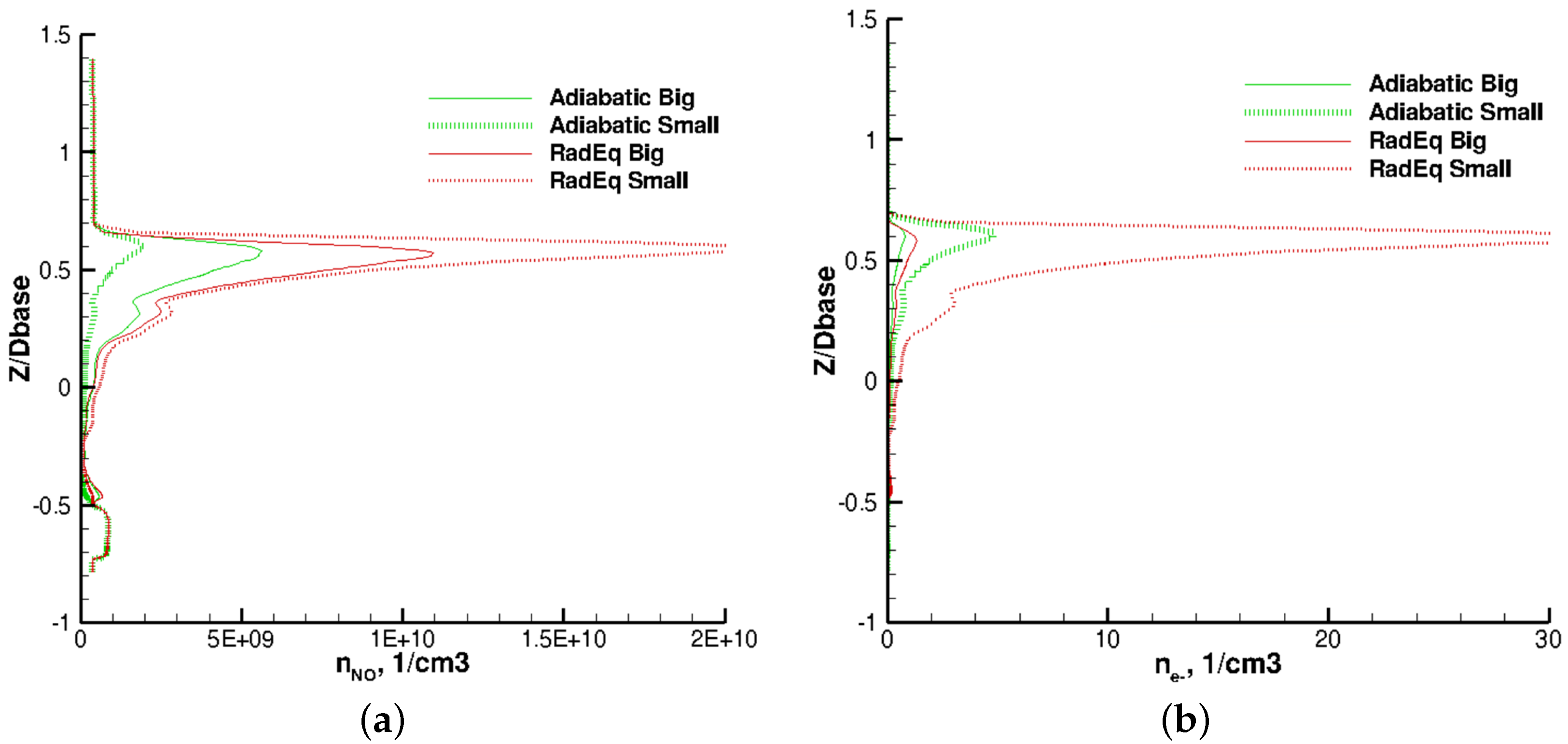
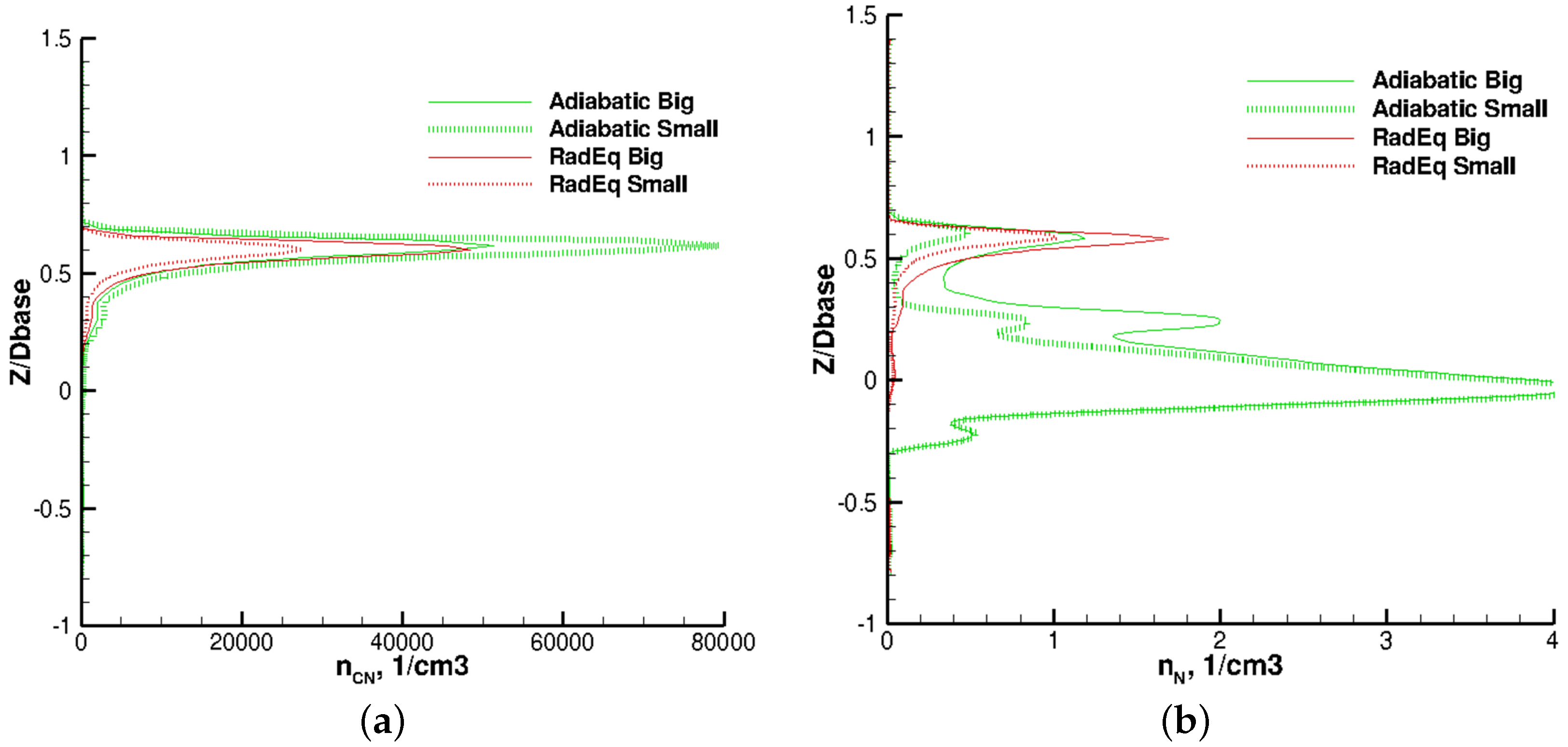
| Flight Condition | Value |
|---|---|
| Mach | 7 |
| Altitude (Km) | 30 |
| Velocity (m/s) | 2115 |
| Angle of Attack (deg) | 5 |
| Density (kg/m3) | 0.01841 |
| Temperature (K) | 226.5 |
| Reynolds Number | 9,237,700 |
| 7-Species Model (a) | |
| Species | Concentration |
| N | 6.22× |
| O | 7.76× |
| N2 | 0.737795 |
| O2 | 0.262205 |
| NO | 1.00× |
| NO+ | 4.57× |
| e− | 8.35× |
| 13-Species Model (b) | |
| Species | Concentration |
| N | 6.22× |
| O | 7.76× |
| N2 | 0.737795 |
| O2 | 0.262205 |
| NO | 1.00× |
| NO+ | 4.57× |
| e− | 8.35× |
| C | 1.00× |
| C2 | 1.00× |
| C3 | 1.00× |
| CO | 1.00× |
| CO2 | 1.00× |
| CN | 1.00× |
| Case | Wall Boundary Condition | Wall Catalycity | Ablation |
|---|---|---|---|
| 1 | Radiative Equilibrium * | Non-Catalytic | Off |
| 2 | Radiative Equilibrium | Fully-Catalytic | Off |
| 3 | Radiative Equilibrium | Non-Catalytic | On |
| 4 | Radiative Equilibrium | Fully-Catalytic | On |
| 5 | Radiative Equilibrium | Equilibrium Catalytic | On |
| 6 | Adiabatic * | Non-Catalytic | Off |
| 7 | Adiabatic | Non-Catalytic | On |
| 8 | Adiabatic | Fully-Catalytic | On |
| 9 | Cold | Non-Catalytic | Off |
| 10 | Cold | Non-Catalytic | On |
© 2018 by the authors. Licensee MDPI, Basel, Switzerland. This article is an open access article distributed under the terms and conditions of the Creative Commons Attribution (CC BY) license (http://creativecommons.org/licenses/by/4.0/).
Share and Cite
Satchell, M.J.; Layng, J.M.; Greendyke, R.B. Numerical Simulation of Heat Transfer and Chemistry in the Wake behind a Hypersonic Slender Body at Angle of Attack. Aerospace 2018, 5, 30. https://doi.org/10.3390/aerospace5010030
Satchell MJ, Layng JM, Greendyke RB. Numerical Simulation of Heat Transfer and Chemistry in the Wake behind a Hypersonic Slender Body at Angle of Attack. Aerospace. 2018; 5(1):30. https://doi.org/10.3390/aerospace5010030
Chicago/Turabian StyleSatchell, Matthew J., Jeffrey M. Layng, and Robert B. Greendyke. 2018. "Numerical Simulation of Heat Transfer and Chemistry in the Wake behind a Hypersonic Slender Body at Angle of Attack" Aerospace 5, no. 1: 30. https://doi.org/10.3390/aerospace5010030





